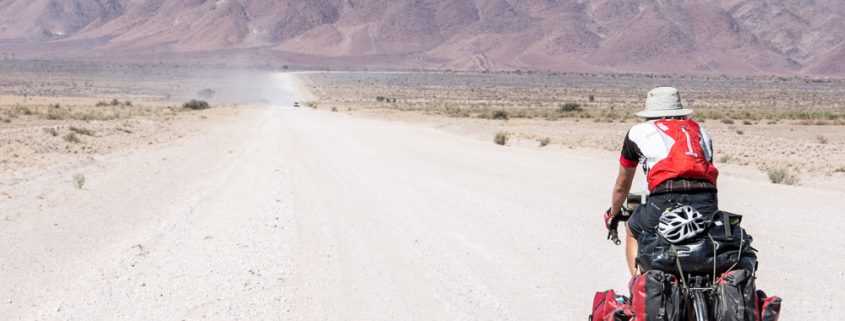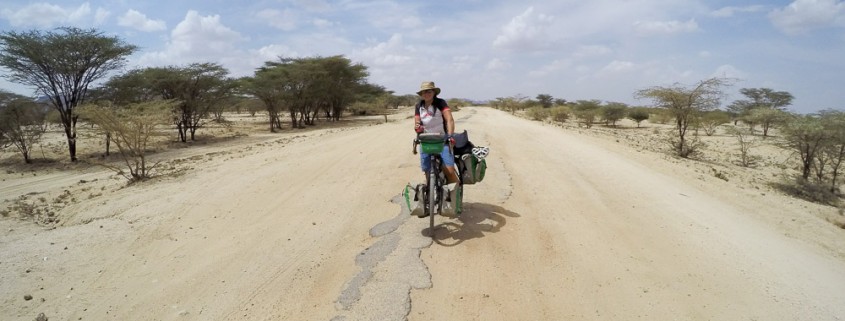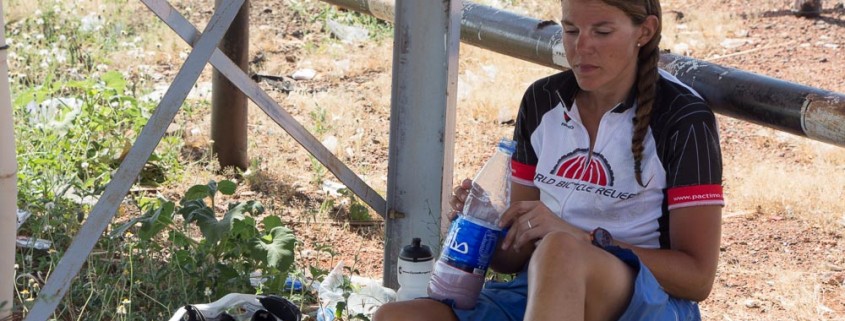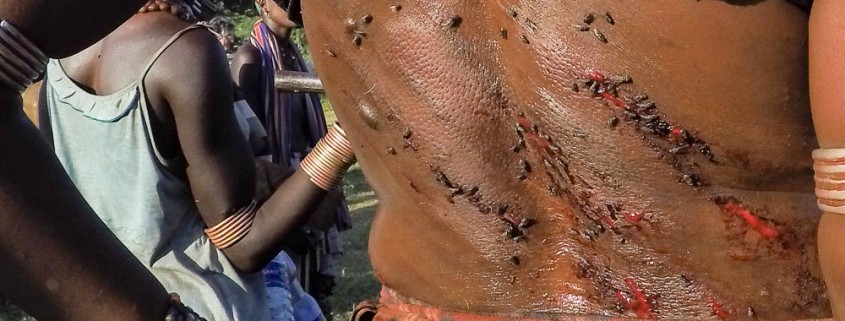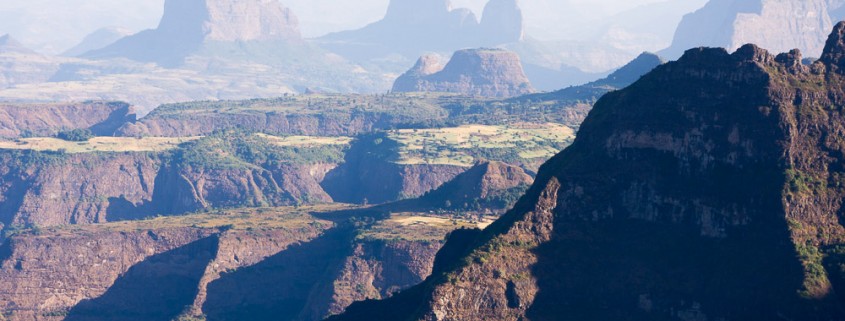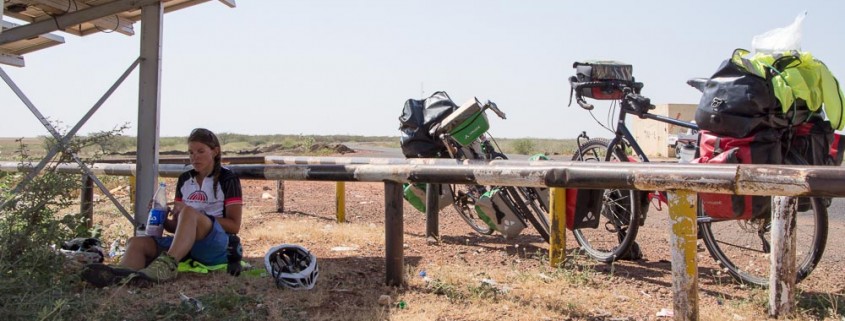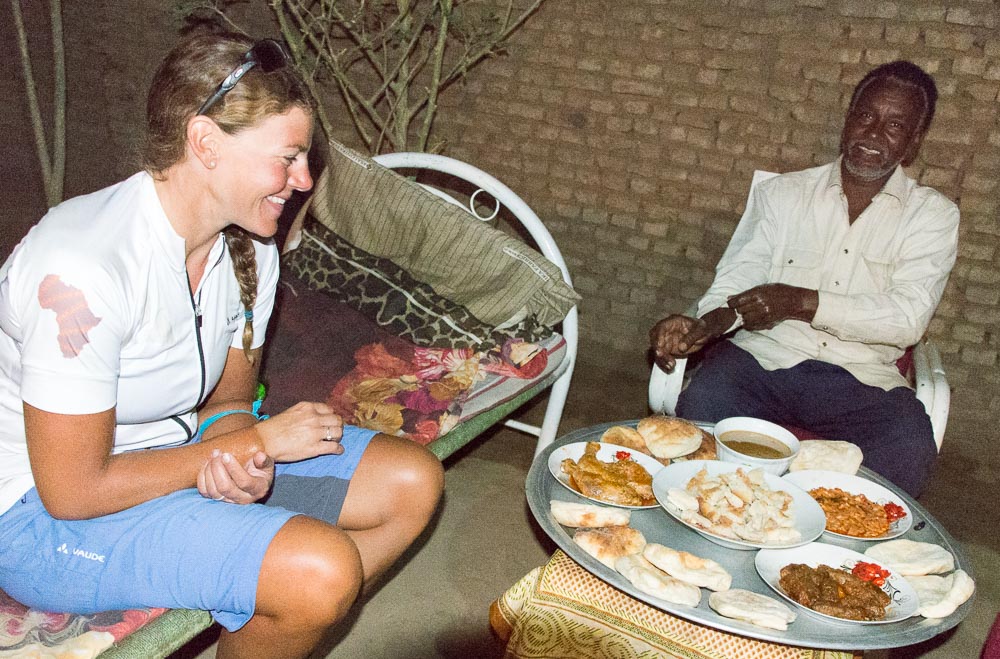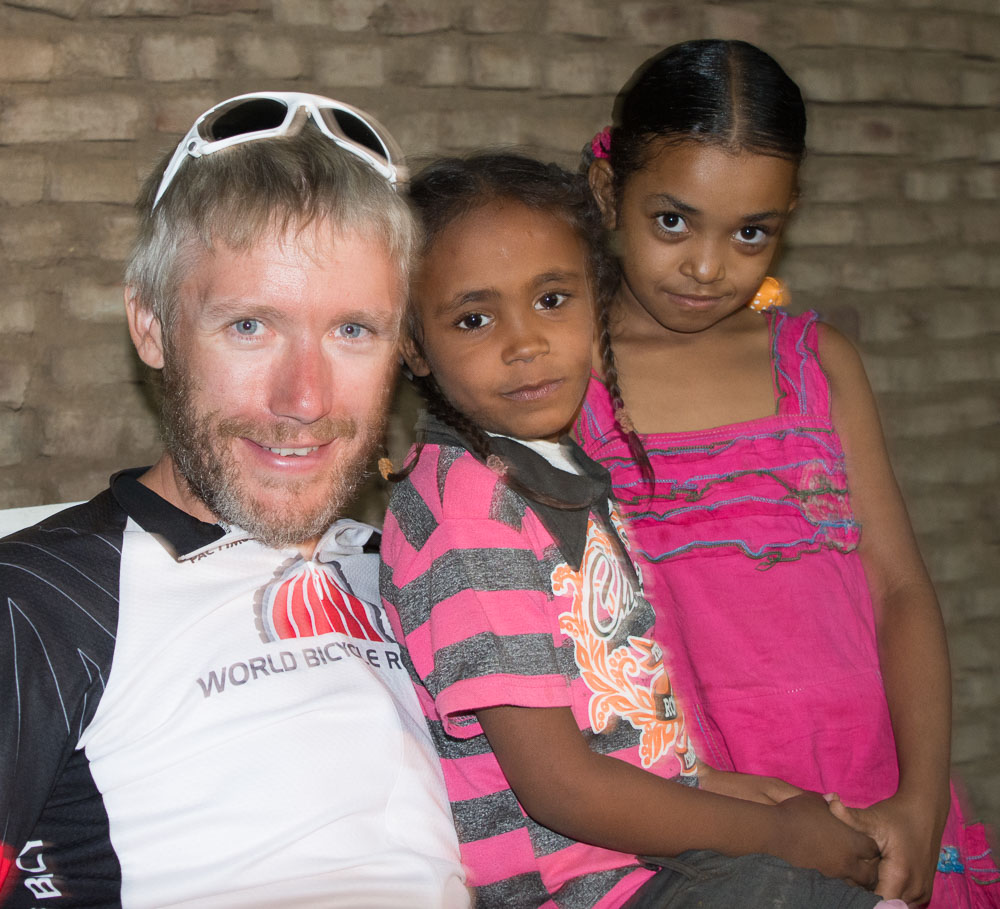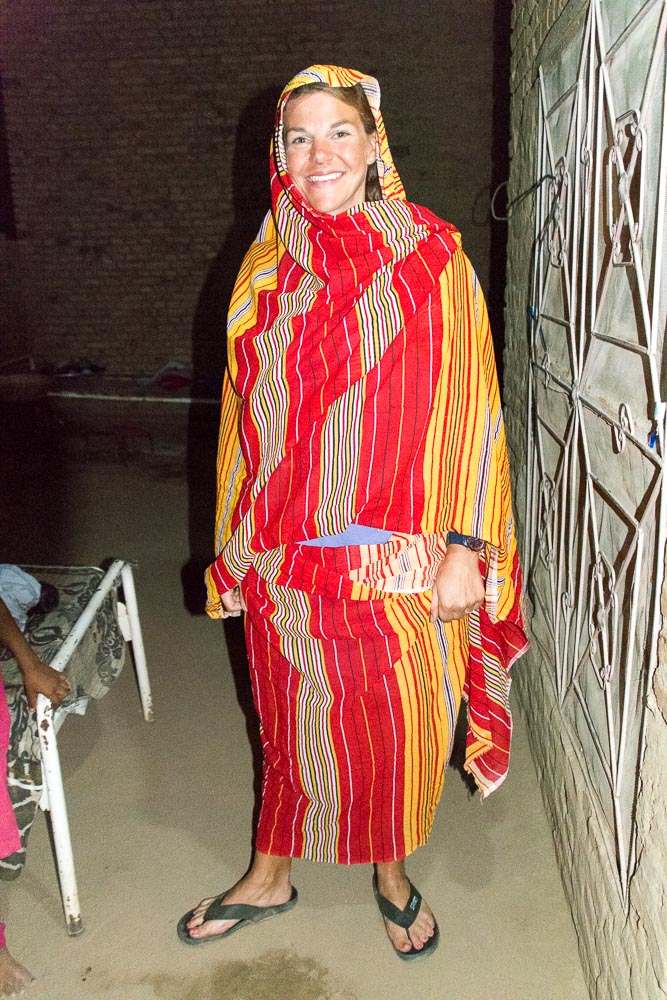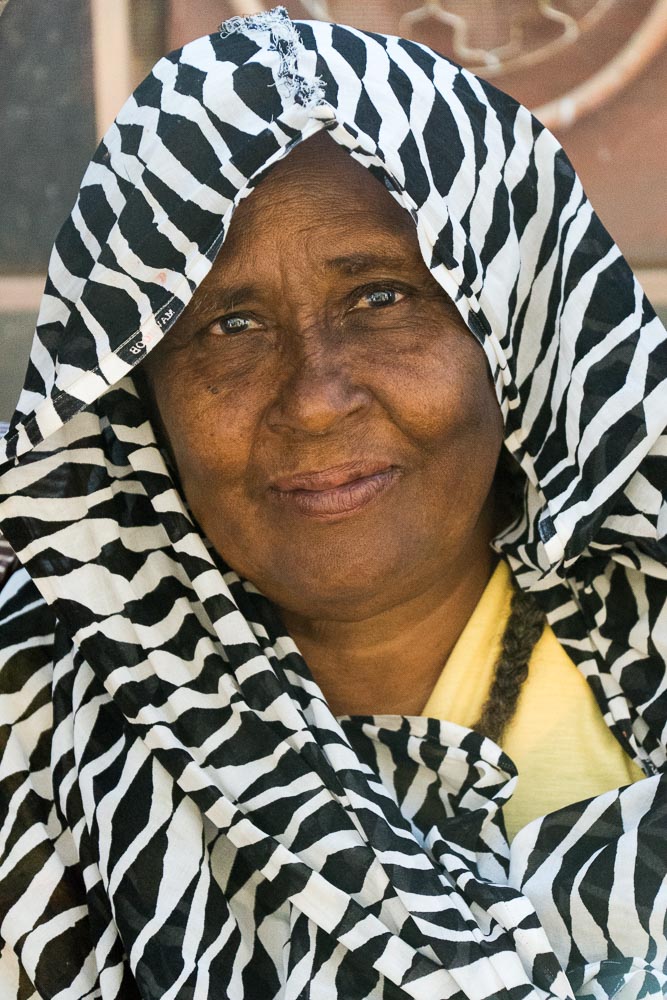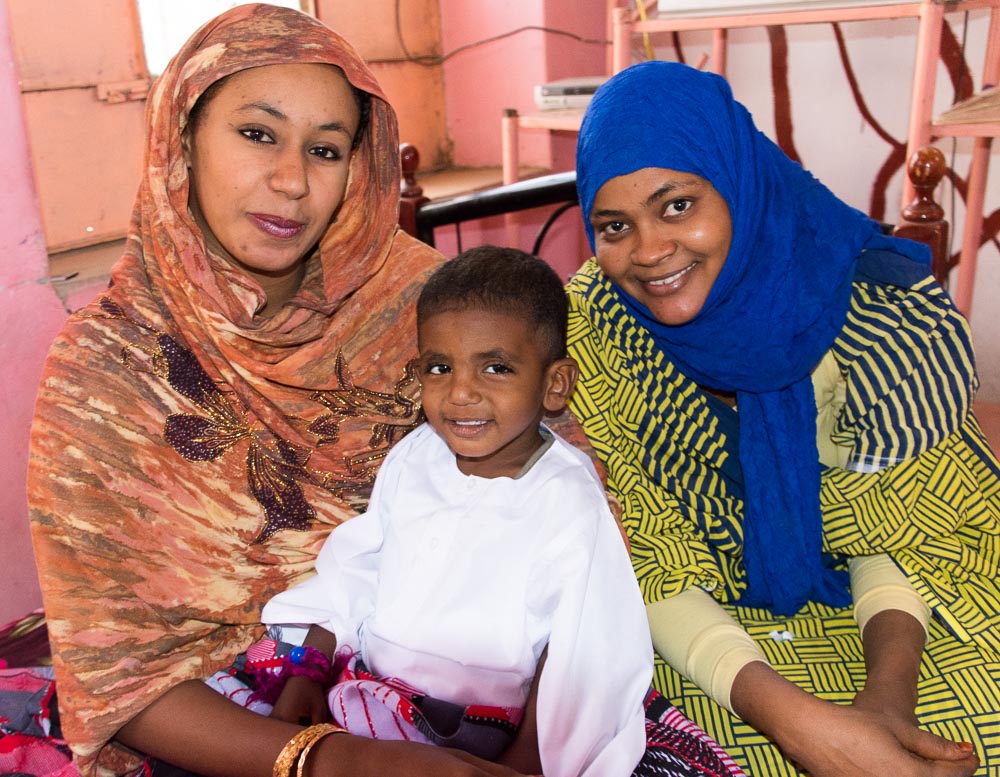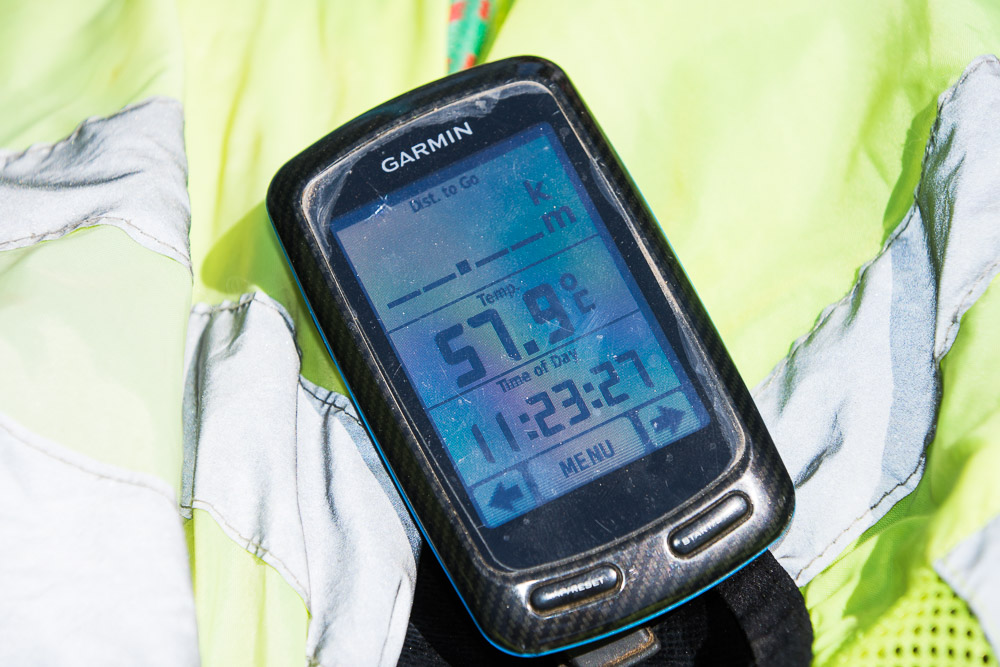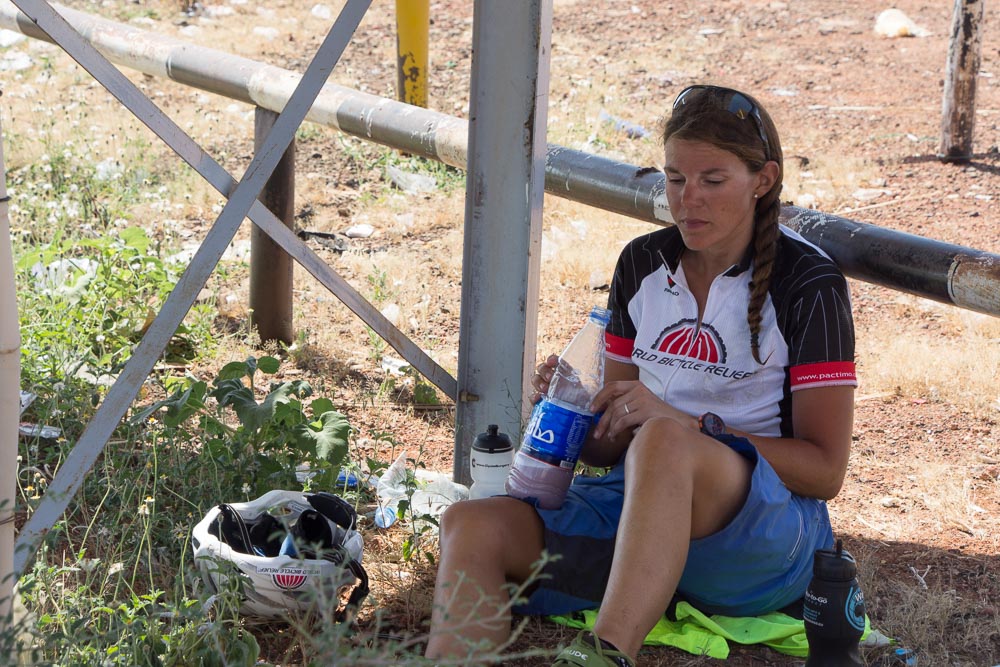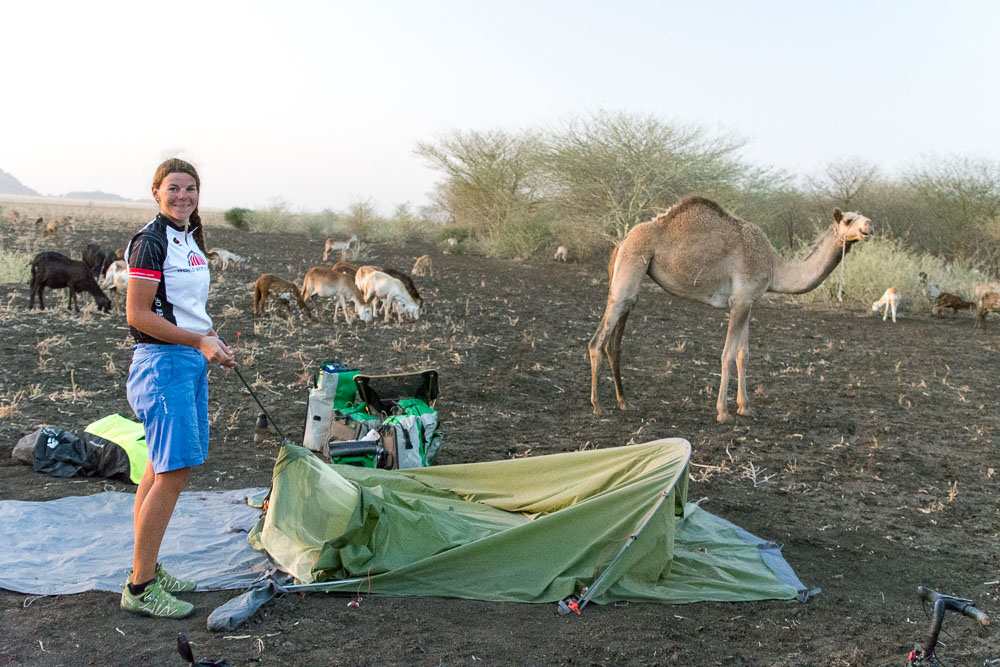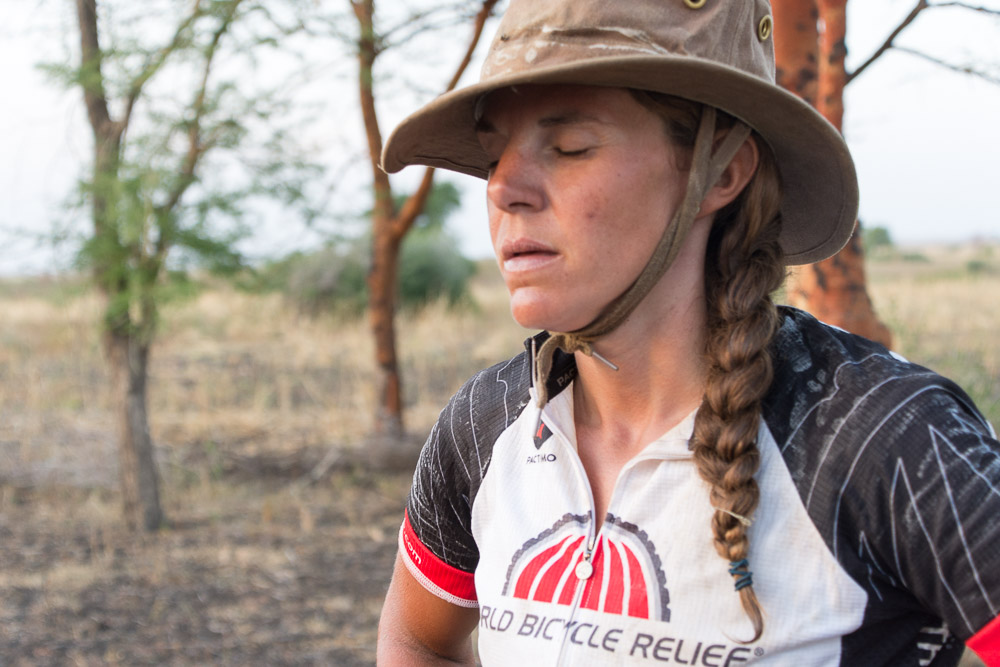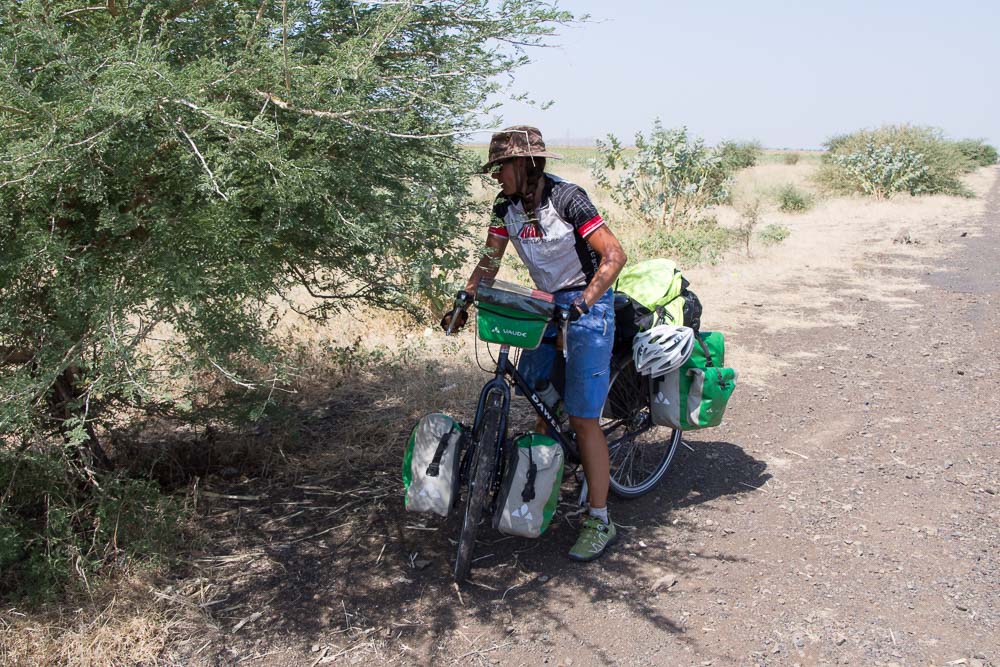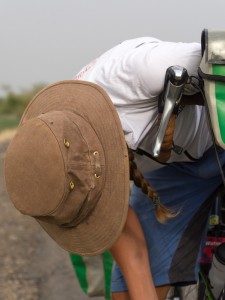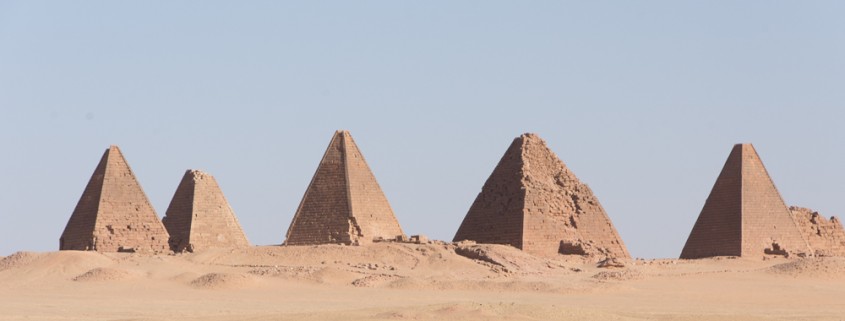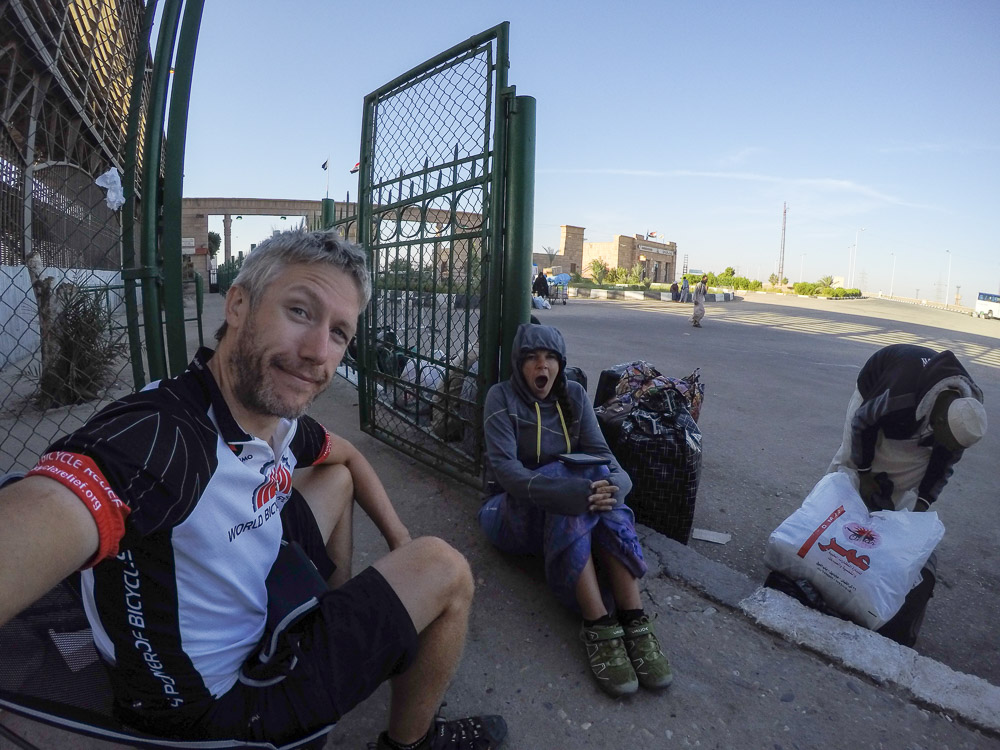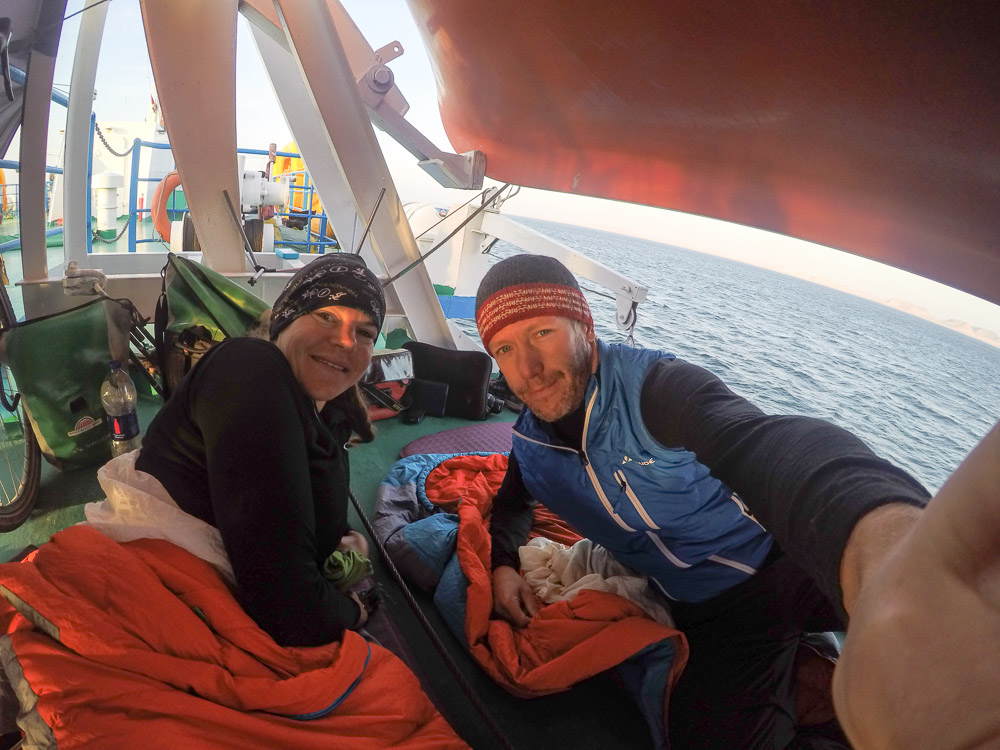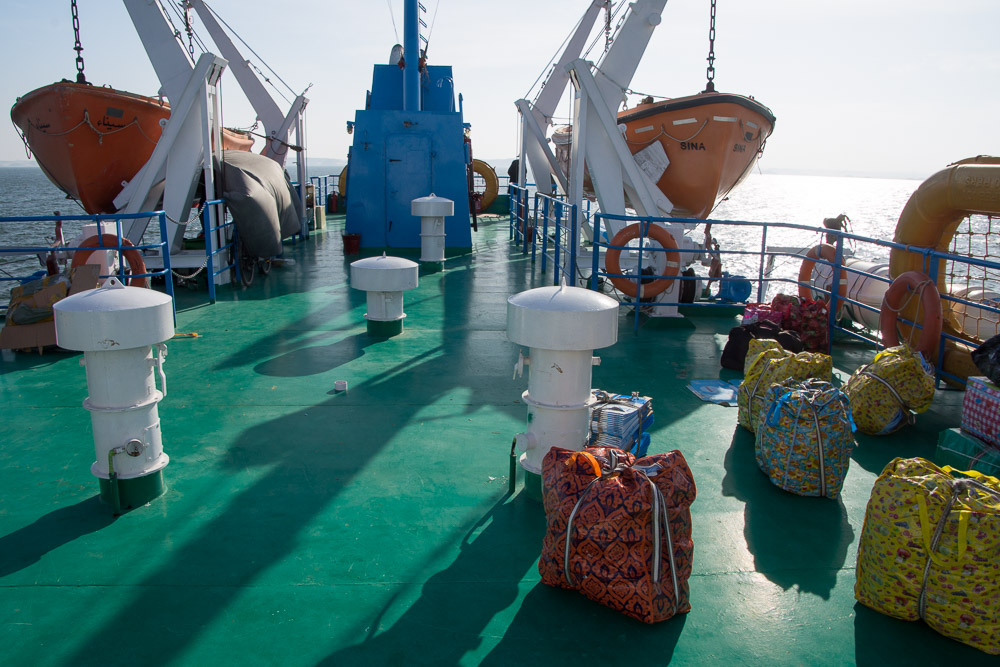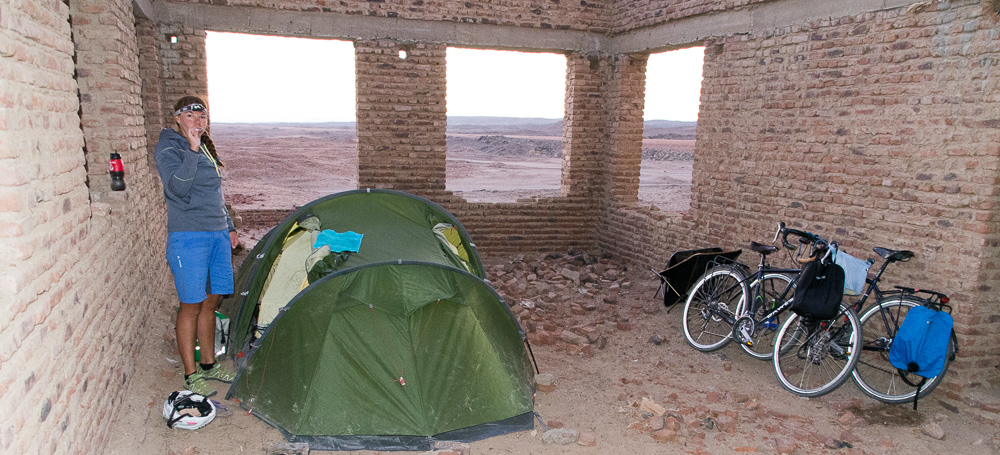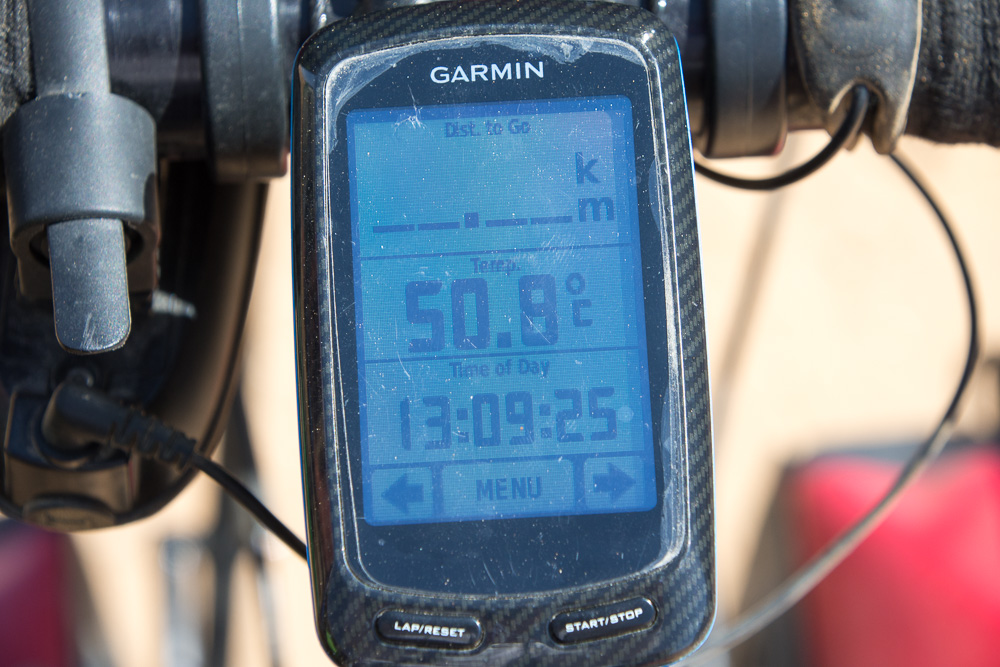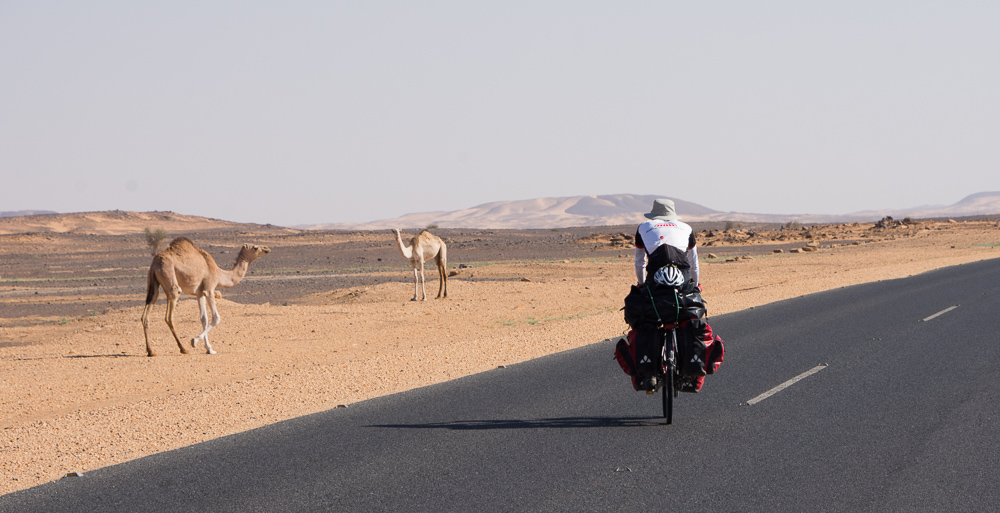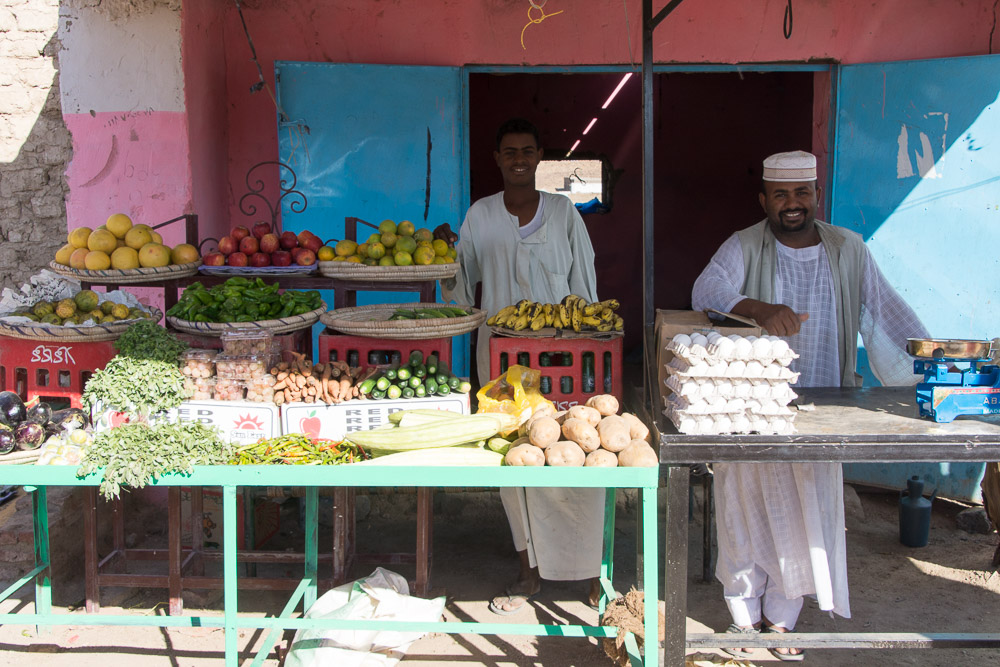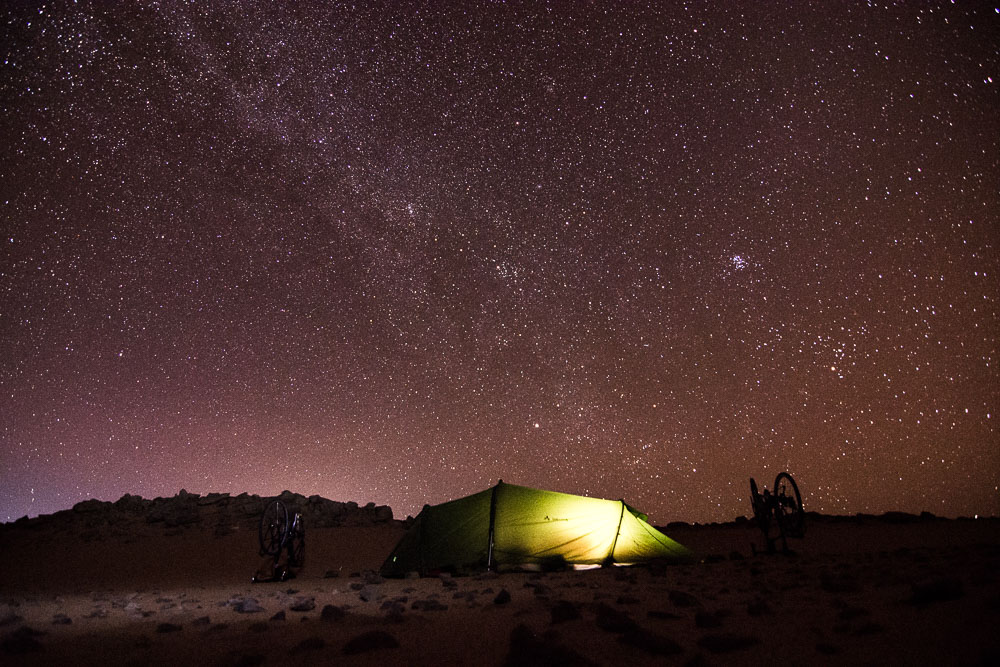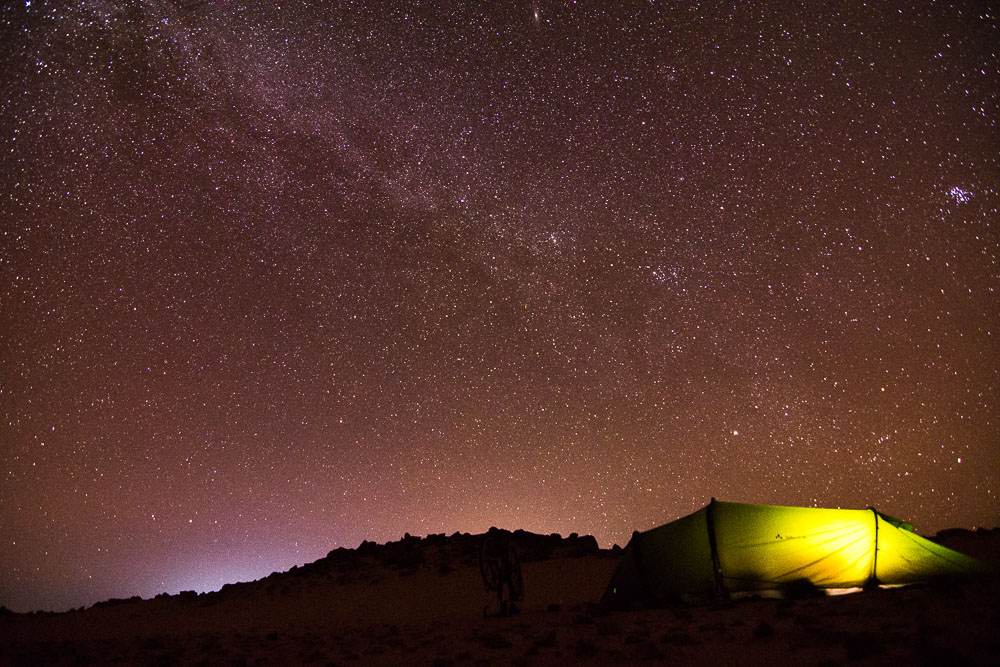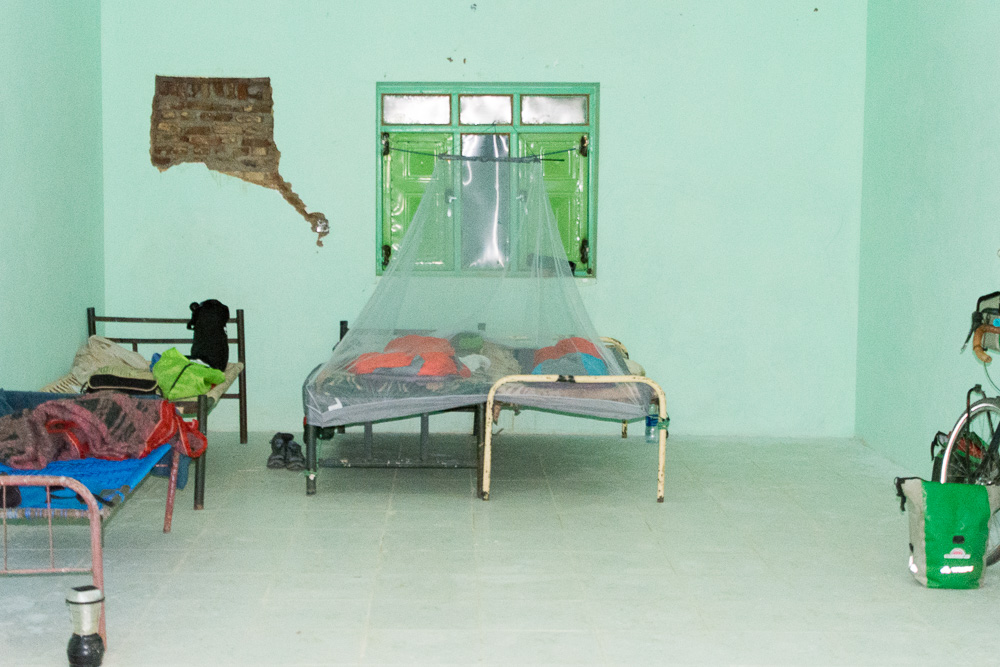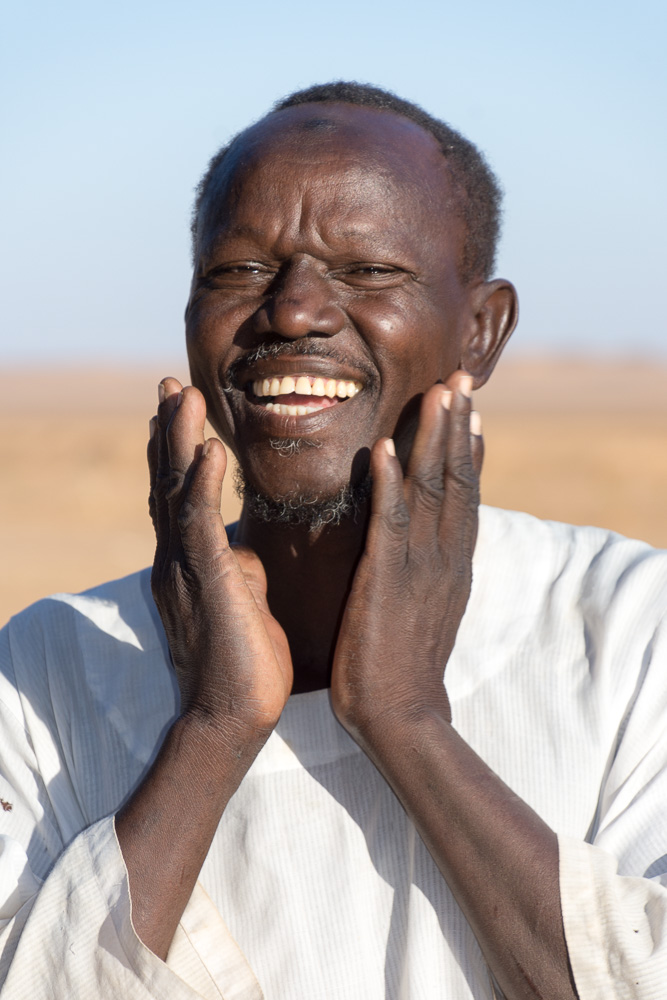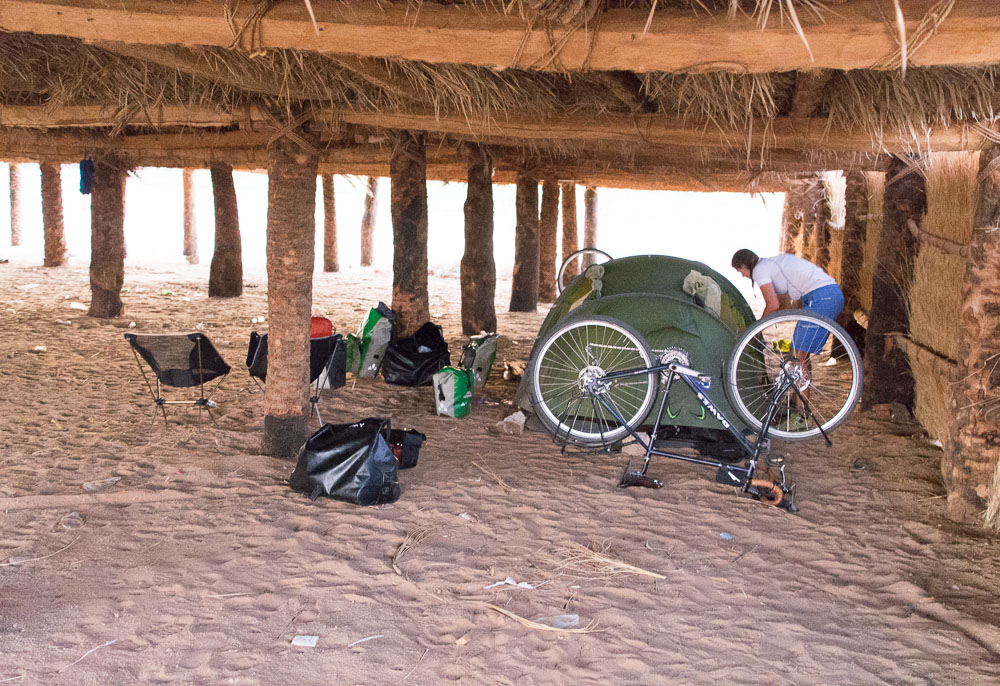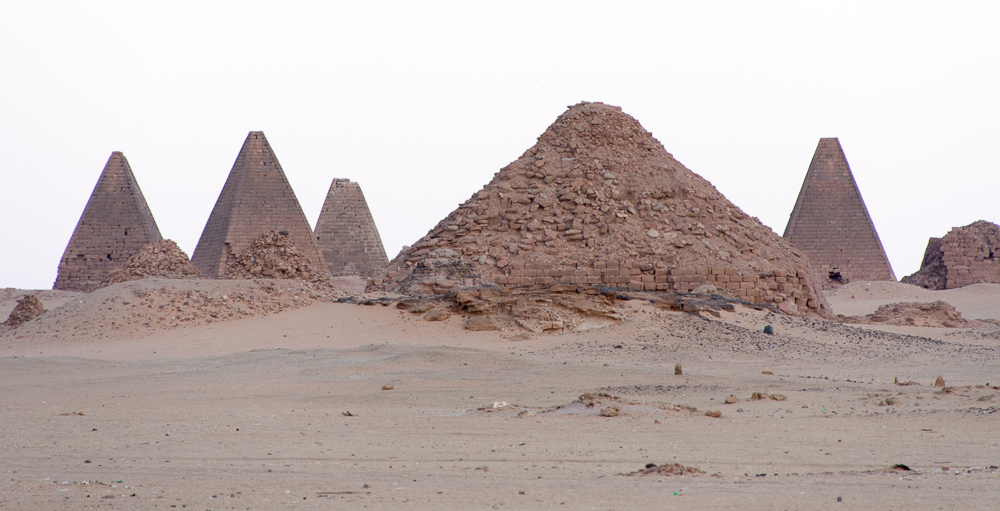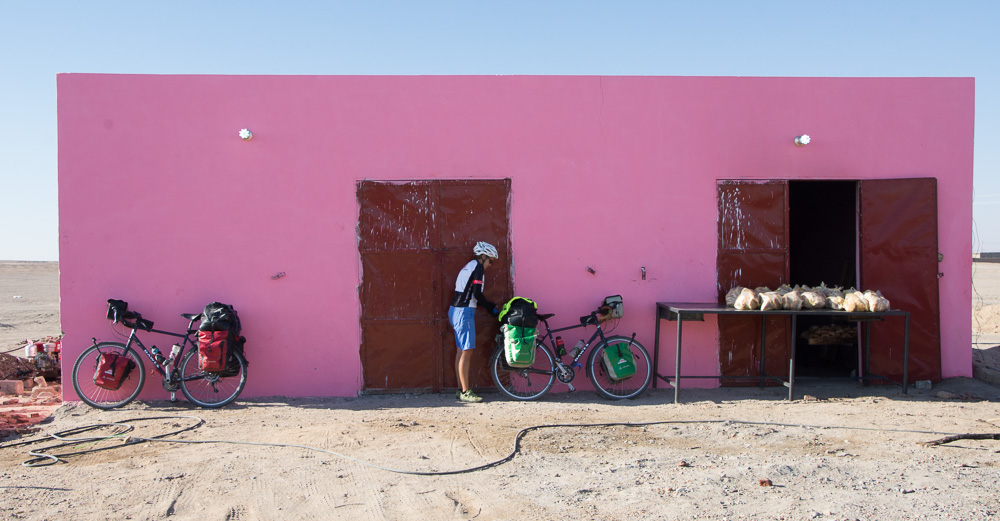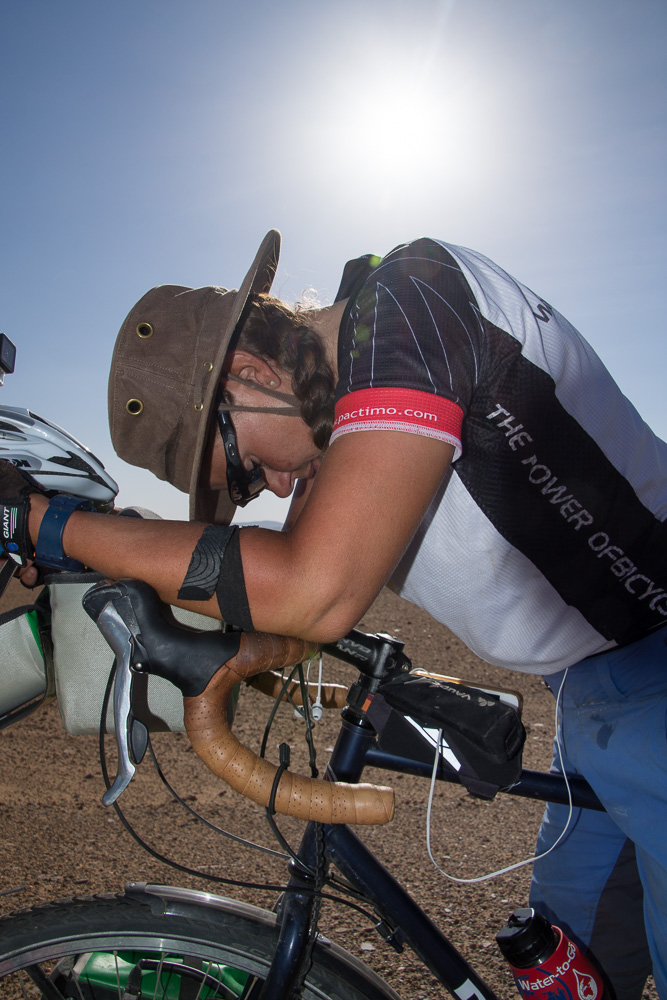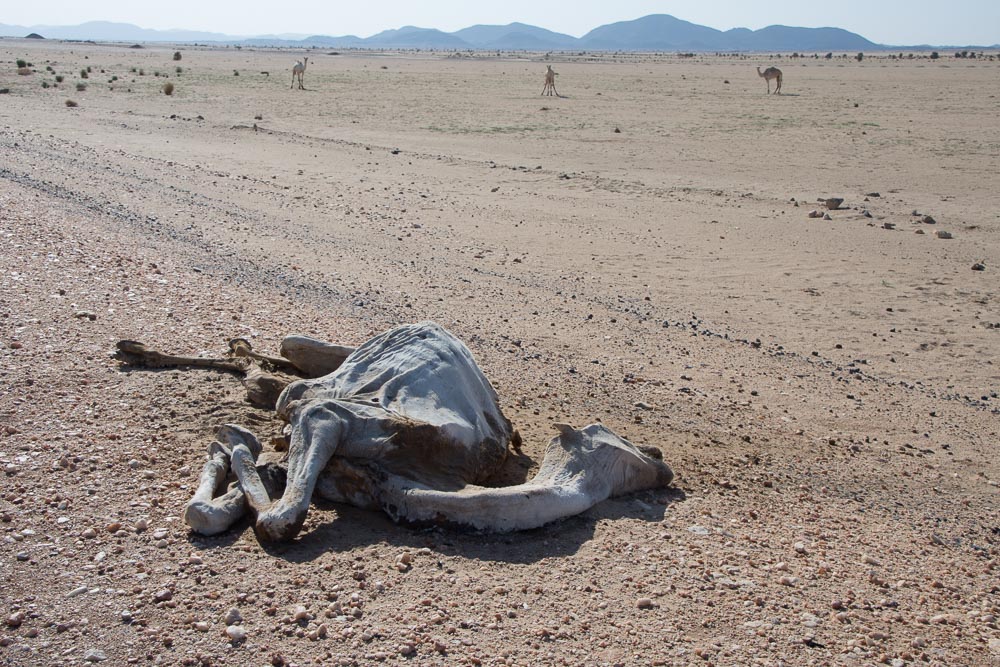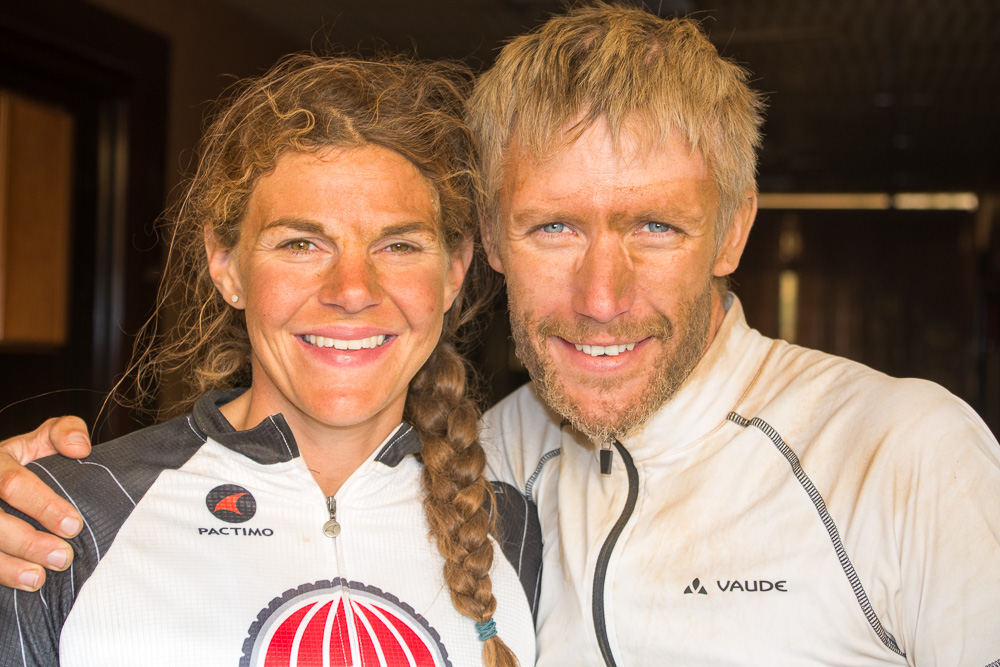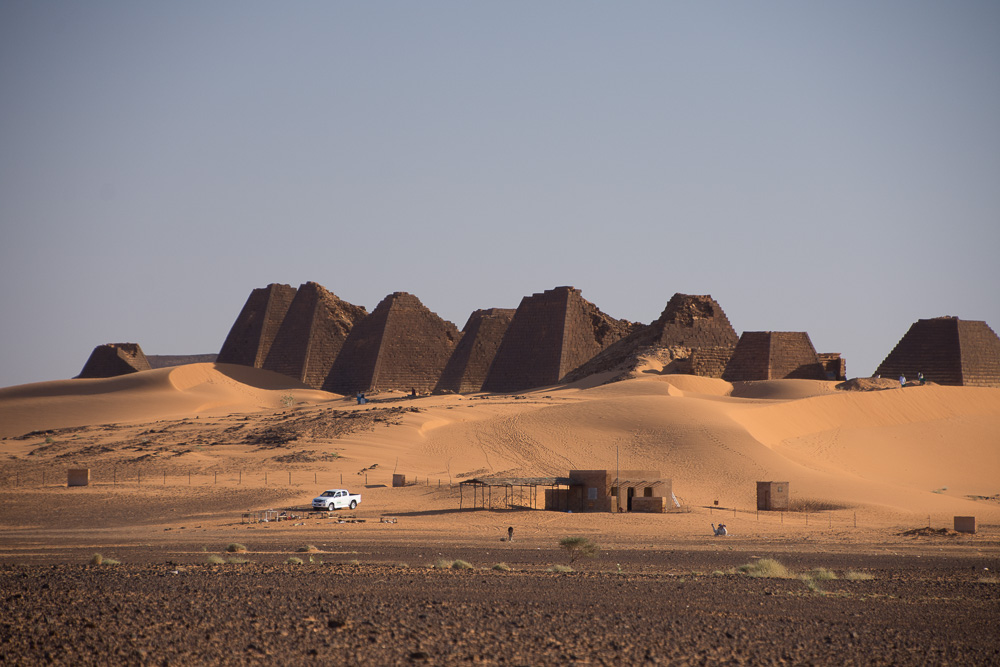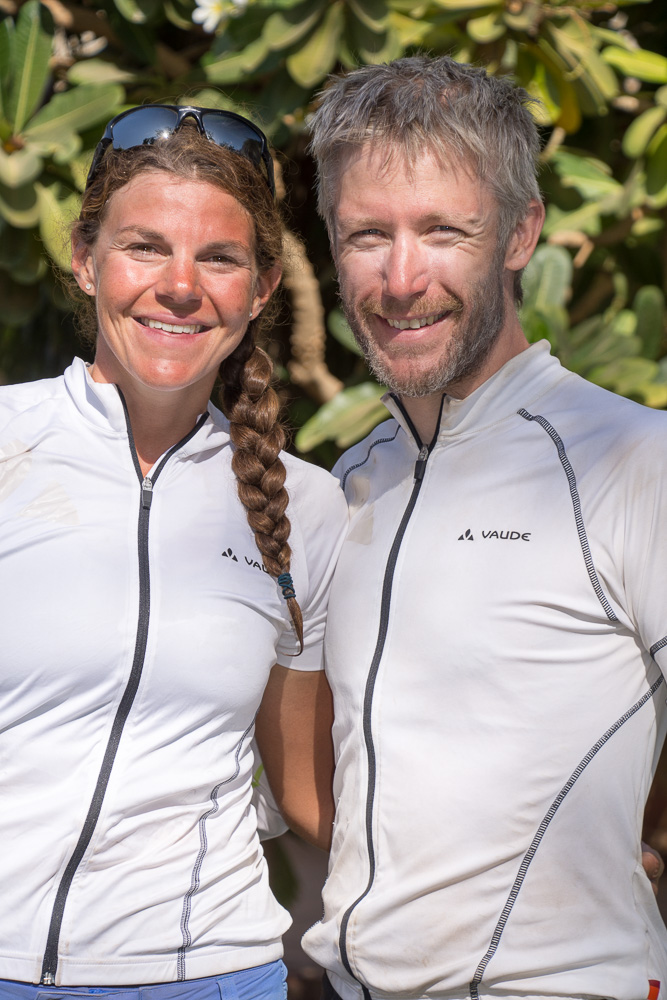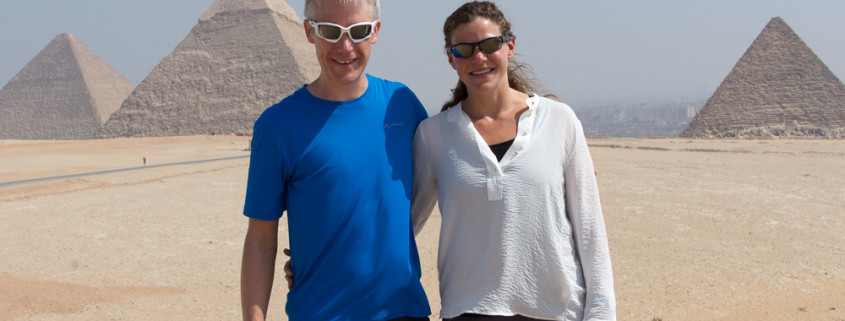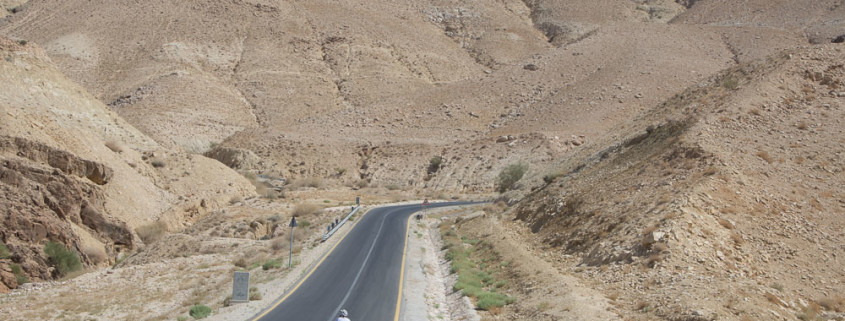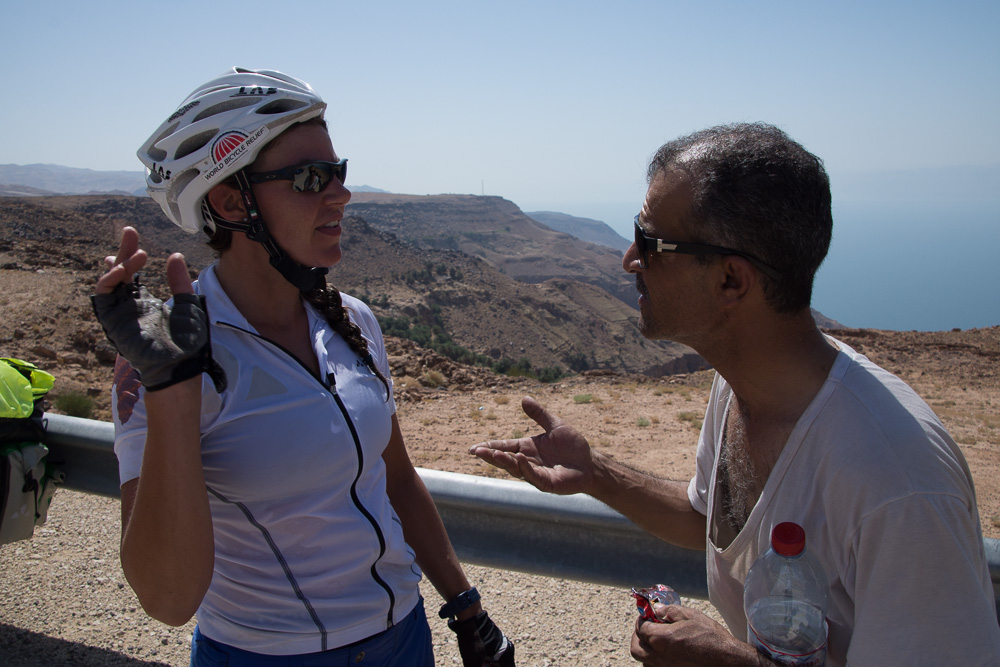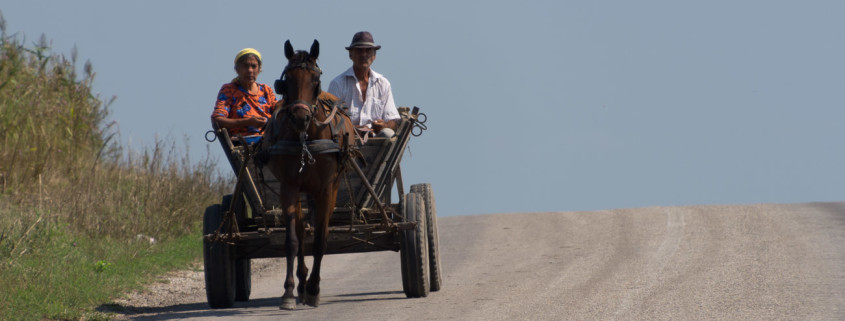Posts
What a difference a week makes! Cycling from Lodwar, Kenya to Jinja, Uganda
/in Cairo to Cape Town, Kindness of strangers, London to Cape Town /by Emily Conrad-PicklesListening to your body: when things don’t quite go to plan
/in Cairo to Cape Town, London to Cape Town /by Emily Conrad-PicklesStopping your journey to seek help can sometimes be the hardest thing to do. But that’s exactly what we’ve had to do this past week. When we arrived in Lodwar we were exhausted and, once again, I was not feeling well at all – the symptoms that I experienced in Sudan had come back and I was not happy with how I was feeling. I felt broken and needed some help.
I got in touch with Paddy, who we met in Sudan, who is currently driving from Cornwall to Cape Town with his wife Libby and their two lovely kids Elsie and Hal. Paddy is a doctor and expedition medic and had kindly agreed to support us on our cycle from Cairo to Cape Town should we have any medical issues.
After a few emails from the road and a long telephone conversation, it was clear that he was not happy with the situation and was keen for me to go to a hospital to get checked out sooner rather than later. I explained that we were in the middle of nowhere but were due to get to Kampala in Uganda in just over a week. However, Paddy was clear that I should get to hospital sooner than that.
We were in a remote town called Lodwar in North West Kenya where we found a hospital. However, I soon discovered that they did not even have an ECG machine (or much at all) so this was not going to be good enough. After a number of phone calls and help from some incredibly kind and helpful contacts here on the ground, we were on a flight to Nairobi from Lodwar the first thing the next morning and by 11am I was sat in the waiting room at the Aga Khan University Hospital.
It’s sometimes hard to admit that there is something not quite right. By now I’d rested for a few days and was feeling much better but you have to take a deep breath from time to time and allow yourself to stop what you are doing and get some help. And I’m pretty glad that I did.
After three days in and out of the hospital, hours of waiting around and some incredibly painful conversations with insurance companies, we think we now know what’s been going on.
It turns out my body has not been receiving what it’s needed to cope with cycling (or pushing!) such long distances in the heat and, combined with a hydration, calorie, and chemical deficit, it has caused me to become unwell.
On the plus side, I do not have malaria or any strange tropical disease and having had my heart thoroughly investigated and all my bodily functions checked I do not have any problems with the important vitals, which is great. What I did have was an electrolyte imbalance in my body but little did I know that, if left untreated, it can be pretty dangerous.
Having done a fair amount of exercise back home, I’ve always been aware of how important electrolytes are but no one ever seems to tell you why and what they do. It transpires that I was about to learn the hard way how important they are to the normal functioning of your body, let alone when you are cycling a 70kg bike across Africa.
Sodium, chloride, calcium, magnesium and potassium are the most common electrolytes in our bodies. They are essential for many important body functions in your muscles, nerves and muscle functions (including the heart) and also to keep fluid levels regulated. It turns out that if the balance is wrong it causes all sorts of issues and I had most of the symptoms (heart palpitations, dizziness, nausea, cramp, irritability (sorry James!), fatigue) and I generally felt utterly dreadful.
From reading more about the importance of electrolytes in the proper functioning of your body, I’m so glad we stopped, rested properly and had that I had a thorough medical check.
More specifically, I’ve learnt that electrolytes (sodium, potassium, magnesium and calcium) are all involved in the contraction and relaxation of the heart and an imbalance of these electrolytes is a common cause of palpitations and arrhythmias (iregular heartbeat). In particular, potassium levels are incredibly important and we found my potassium levels had dropped well below the normal range. Without these vital ingredients the heart cannot contract or relax properly – I don’t think you need to be a doctor to realise that this is not ideal, especially when you are miles from home (and civilisation) cycling to Cape Town.
Paddy had also worked out my calorie intake and outlay and it seems that there was definitely not a good balance with a lot more energy being burnt then replaced. Despite us doing our very best, it seems that we are just not putting enough fuel into the engine. Combine that with temperatures well over 40 degrees Celsius, a lot of sweating and a repeated upset stomach – you can see why I have had a few problems.
The hospital we visited was exceptional. I have never received such great treatment. What’s more, they are a teaching hospital and at every stage the more junior doctors were allowed to examine me and give their opinions before the consultants. It was all done in such an organised, calm way that I could not help but be impressed. I’ve tried out some cool kit too and had an ultrasound of my heart and a stress ECG which is when they put you on a running machine plugged into an ECG machine and keep making it harder until you crack. It’s the sort of thing that I’ve always wanted to do for a fitness test, but when you are in a cardiology department it seems to have a different meaning. James, however, seemed to forget where we were and I think was enjoying it a little too much shouting at me to keep going and seemed thoroughly disappointed when I called an end to the test!
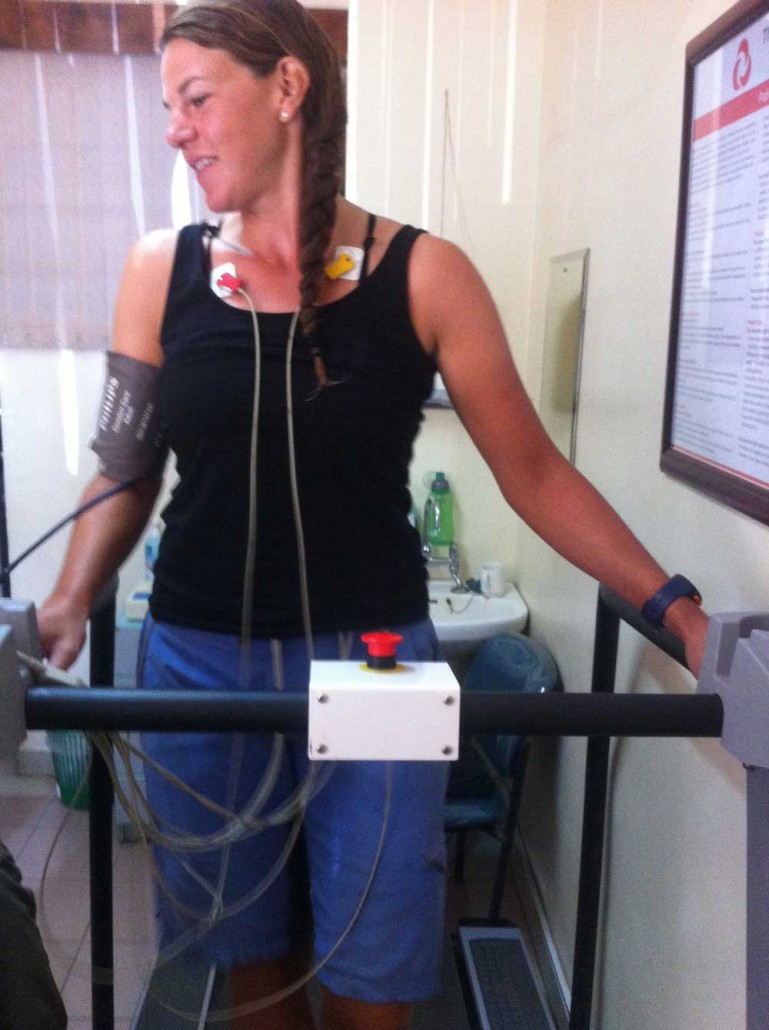
Watching my heart beat while doing a Stress ECG
I now need to work out how to keep my electrolytes balanced to stop me from getting sick.
So now I will take potassium, magnesium and calcium supplements every day to try to stop levels from dropping so low again. We’ll also be making an electrolyte mixture every day (sugar and salt in water) and hope to pick up some more High 5 Zero tabs as quickly as we can as they contain a good balance of electrolytes in them to keep us going.
I’ll be listening more closely to my body and how it is feeling. We all think that we can just keep on going but we simply cannot do this without the correct fuel and chemical balance inside. I’ve learnt the hard way about the importance of electrolytes and I’m ashamed to think that previously I just thought that you took electrolytes to help you go faster. I now know that without them your body will stop functioning and can have lethal consequences.
Paddy, thank you for your help and for making me stop and come and get checked out. We are so grateful for your help and for letting us stay with you all for a few days in Nairobi.
Tomorrow we fly back to Lodwar and continue our journey on Tuesday morning and look forward to sharing our experiences of Western Kenya and into Uganda!
If you’ve enjoyed reading this blog post, please donate to World Bicycle Relief. Every penny goes to the great work the charity does in Africa – not to fund our expedition in any way.
Cycling the Lower Omo Valley to Omorate and on to West Turkana
/in Cairo to Cape Town, London to Cape Town /by James DavisWe would have loved to stay in Addis Ababa for Christmas. But, alas, we had to race to Kenya before our visas expired on the 31st December.
From Addis Ababa, the conventional route to Kenya is the road directly south towards Moyale. However, the first few hundred kilometers of the road in Northern Kenya is renowned for bandits and we’d therefore either have to take transport or an unnecessary risk.
Another option was to head southwest from Addis into the remote tribal lands of Ethiopia before crossing the border at the northwest of Lake Turkana in a no-mans-land between Ethiopia, Kenya and South Sudan. This route isn’t without its dangers though. But, for the touring cyclist, it offers the chance to see various tribes up close and to visit one of the remotest parts of Africa. We decided to give it a go.
Once we escaped the traffic on the road out of Addis, we had a straightforward 80km to Kela on decent road. Except, that is, for the reemergence of the children who, at each and every opportunity shouted the country-wide catchphrase of youyouyouyouyouyouy…moneymoneymoneymoney…penpenpenpenpen whilst running after us. Rocks were thrown.
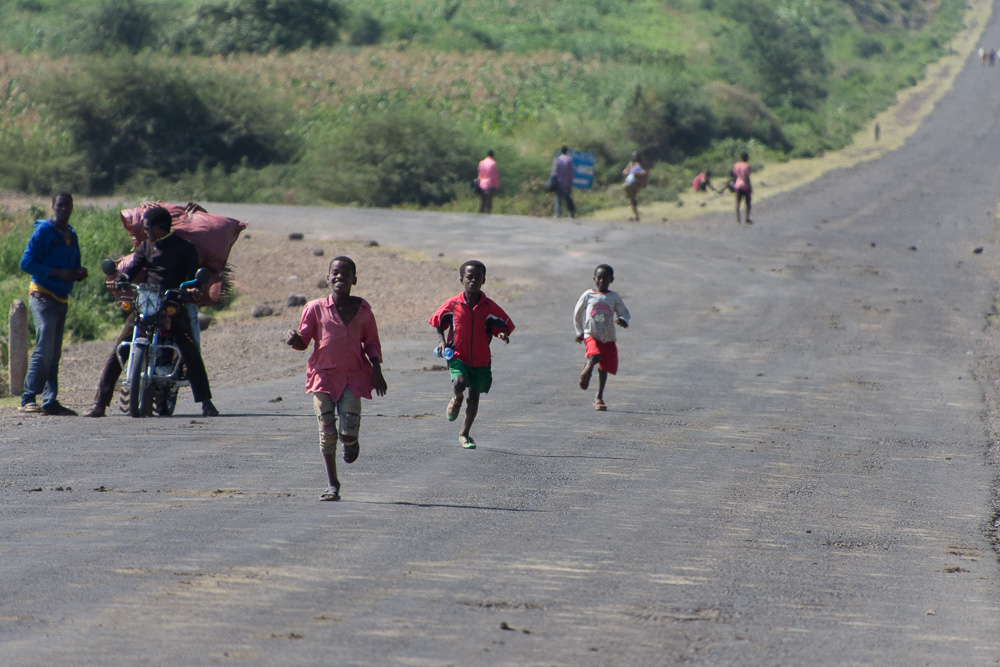
At Kela, we checked into a grotty ‘hotel’ in the centre of town. We couldn’t blame them for not having running water or a reliable power supply. But we both took exception to the turd we found in the sink of our en-suite ‘bathroom’. Luckily for the boy I made to clean it up, it wasn’t a fresh one so he was able to chip away at it until it came off the basin.
The next morning we passed through Butajira and were astonished to find a plush western-style hotel. We stopped for a cup of tea in the marble-clad restaurant and decided that, as it was Christmas day, we would find somewhere nice to stay that evening where, hopefully, there wouldn’t be any poos in the basin to greet us.
We aimed towards Hosaina where we had been promised a decent hotel and since it was Christmas Day we were extra motivated to reward ourselves with a cold beer and a pizza.
Further down the road, we looked in dismay at our intended turnoff towards Hosaina because the road was nothing but a stretch of rubble. We opted to continue on the tar road but this meant a longer cycle without knowing what the elevation was going to be like.
We didn’t think the road would be too hilly, but we were taken by surprise.
We spent 10 hours in the saddle on Christmas day. We covered 145km and ascended over 1,600 meters. All to the constant and irritating accompaniment of youyouyouyouyouyouyouyouyouyouyouyouyou, moneymoneymoneymoneymoneymoneymoneymoneymoneymoneymoneymoney and rocks thrown at us regularly. All Emily could think about all day was her new-found dislike for Bob Geldof as she spent the entire day singing “Do they know it’s Christmas?” and, perhaps unjustifiably, blaming him for the rock throwing child beggars.
Utterly exhausted, we eventually got to Hosaina and limped into the first western-looking hotel we could find. We stumped up an extortionate (550 Birr/£17 for the night compared to our usual 100Birr/£3.00 per night). But, it was Christmas and we thought we’d give ourselves a treat. The 566% increase in cost did not equate to a similar increase in service though. Although we enjoyed cool beers, a pizza and a comfy bed, we had to endure the sound of the very loud Christian Orthodox church across the road wailing all night and, at 3am, I woke the pigeon that had been sleeping in the bathroom and spent 15 minutes trying to catch it as it flapped around the room.

We had a similarly tough ride the next day to Sodo. We saw the first troop of baboons of the trip cross the road ahead of us but the day’s ride itself was made worse by the children and villagers.
As we approached each village, high-pitched screams of “Farange!” would greet us from the sidelines. These shouts rippled up the road before us until the whole village knew to expect us so they could each run out to shout youyouyou, moneymoneymoney, penpenpen and “where-you-go?” at us. With such an early warning system in place, it’s little surprise that Musolini failed to colonise Ethiopia.
At one of the larger villages, we pulled over to the side of the road and, before we could even park our bikes, people had surrounded us. By the time Em returned with two warm bottles of the fizzy stuff, she could barely find me amongst the throng of kids and adults standing, staring, playing with the bikes and asking for money.

Just before we reached Arba Minch, we met Jimmy, a French motorcyclist who was making the long journey from Cape Town to France. He recommended the Bekele Mola hotel to us so we headed there. In their reception they have a sign proudly stating that Ethiopians pay 400Birr and Foreigners pay 580Birr for a room. Camping in the grounds was 300Birr. Needless to say, we weren’t happy with the price differential so negotiated to pay the Ethiopian rate for a room. Which was lucky because warthog roamed the grounds we could have camped in. The view from the hotel’s terrace across the two lakes was stunning and more than made up for the overpriced room and food.
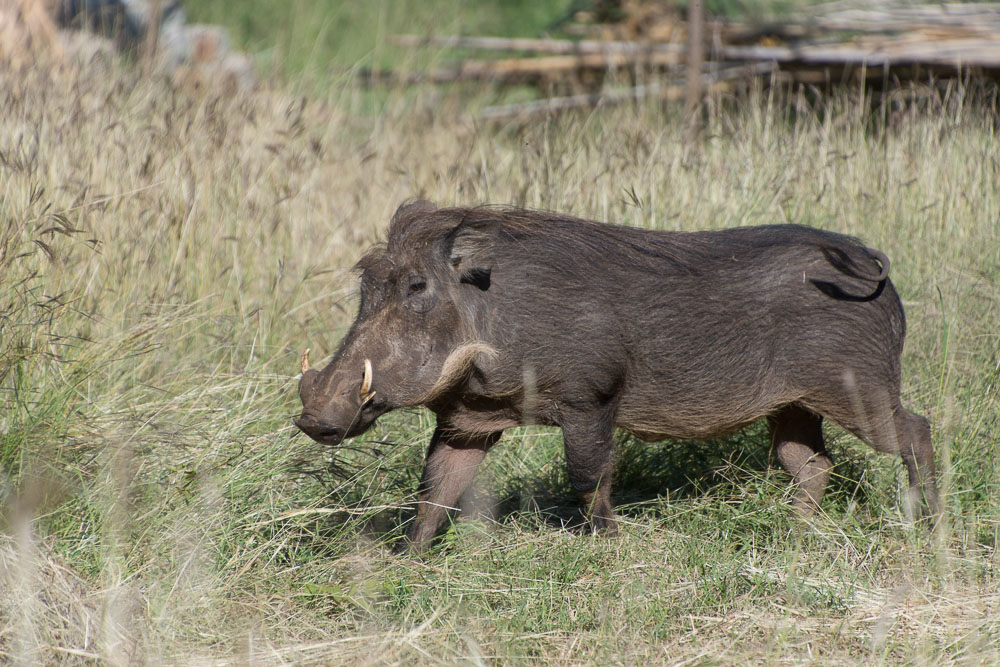
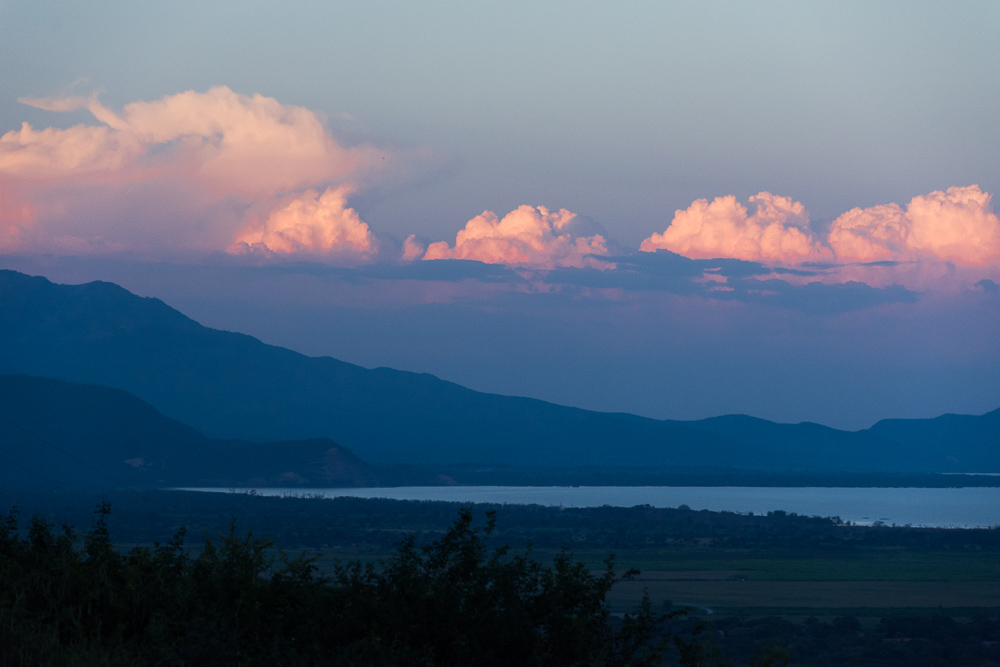
A couple of hilly days’ ride through banana plantations later we made it to Konso. We couldn’t find any decent places to stay in town so we climbed up a massive 20% hill where we’d seen a lodge marked on the GPS. With panoramic views over the countryside (a UNESCO heritage site due to the uniqueness of the hill terraces) and an expensive-looking restaurant, I thought the receptionist had made a mistake when she said it was “55 for the night”. That is, until I realised it was US$55. At that price, we had to find somewhere else to stay…which meant travelling back down the hill we’d just cycled. Thankfully, the lodge agreed to store our bags and bikes and we got a tuktuk into town.
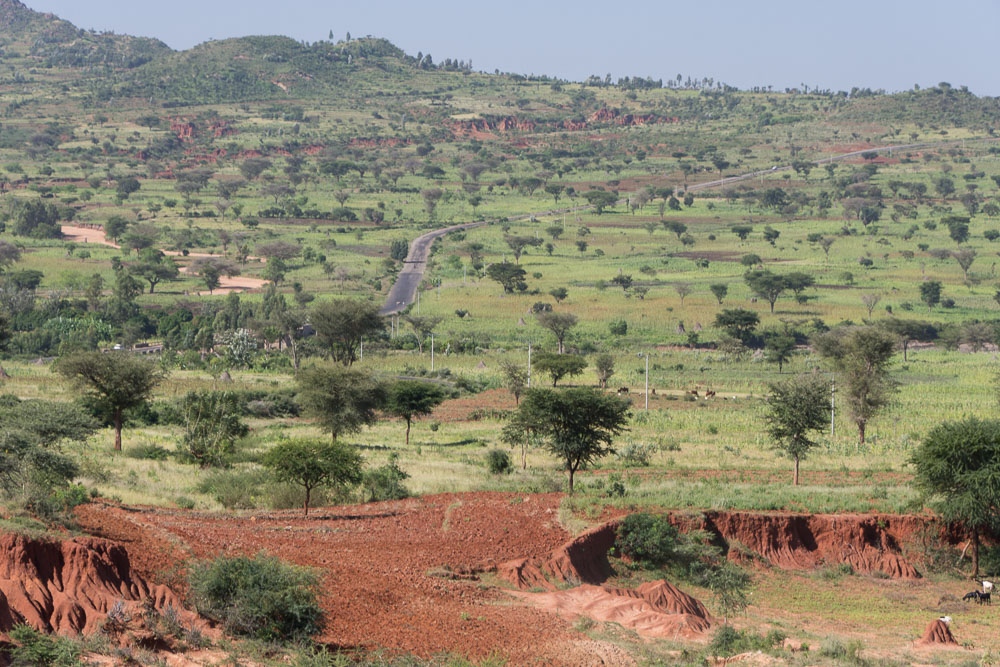
There, we found a much cheaper hotel where I negotiated the price down from 200Birr to 50Birr for the room on the condition we buy a few drinks. We had couple of beers, paid the 50birr for the room and headed into town for some food.
At the restaurant, ordering our meal was tricky. Firstly, as is common with most Ethiopian restaurants and hotels, the TV is on at full volume meaning nobody can hear anything other than the din from blown speakers.
Secondly there’s a bizarre phenomenon that’s quite unique to Ethiopia. When taking an order for food or drink, the waiter will turn on his heels after the very first item you say. It’s happened at nearly every place we’ve eaten. For example, if you wanted one spaghetti and one pizza, you’d barely be able to finish saying “one spaghetti” before he’s off to the kitchen…even though there’s at least one more dish and a couple of drinks to order.
Thirdly, it was another occasion where the waiter insists that there’s only one thing on the menu. We reluctantly order it. Later, whilst we’re eating, other diners who’ve arrived after us are brought much more appetising dishes. When we inquire, the waiter will say that’s available too. When we try to order it, they say it’s run out. I only mention this because it’s happened several times in Ethiopia!
Anyway, we had a reasonable meal and had fun meeting Harley and Emily, a couple travelling from South Africa to Sweden in their Land Rover.

Back at the hotel we were preparing for bed when there was a knock at the door. Apparently the room was now 150Birr and not the 50Birr plus beers I’d agreed. After a long ‘conversation’ I was forced to stump up the 150Birr for the privilege of the grimy room with the sound of yet another TV turned up to number 11 in the courtyard outside our room.
The next morning we took a tuktuk back up the monster hill to collect our kit and bikes. At the lodge, we met Tom and Eva, a South African couple who are travelling Africa in their huge unimog 4X4.
The cycle out of Konso was beautiful but hilly. Every inch of the surrounding hillsides was being used for agriculture in an intricate pattern of interweaving hill terraces.
Then something expensive happened.
I swooped down a lovely decent towards a bridge that crossed a partially dried-out river. What I failed to notice until it was too late was a 15cm ‘step’ right across the width of the road where the bridge joined the tarmac road.
I tried to bunny hop, but with a combined bike and rider weight of over 150kg, I could just lift the front wheel enough for it not to take the full force of the collision. The impact was hard. And a sickening crunch rose up through the wheels, into the frame and into my bones as I collided with the obstacle. I just managed to keep control of the bike and avoided a crash but I was helpless to stop my handlebar bag fly open and all I could do was cling on as I watched my beloved Nikon DSLR camera and various other bits of tech hit the asphalt with an expensive smash.
To their credit the kids hanging around the bridge quickly gathered up all the broken parts and handed them back to me. The camera was dead. I was gutted because of the remote and photogenic region we were to cycle into. But, with no obvious signs of damage to the bike and no injuries, the journey continued.

A short while later, Tom and Eva passed and handed us ice-cold waters from their huge vehicle. After the hot water we’d been sipping from our bottles all week, the crisp coolness of fresh icy water was like sipping vintage champagne.
Tom said they were headed to a campsite 75km away. It was 1pm and 75km in an afternoon is quite punchy for anyway but, with Tom’s promise that a cold beer would be waiting for us, we decided to give it a go.
At Woyto, there’s a junction. The asphalt road continues on a longer, potentially hillier road towards Omorate. The turning left is on a hard-packed rough road but it’s shorter. We met Christian, a missionary form Iceland who was visiting friends in the area. He advised that the shorter but unsealed road was best for us. We took his advice and I lead the pace on what Emily called “James’s Omo Valley Training Camp”. Tom’s ice-cold beer was a big carrot dangling in front of me!
Our chosen road took us across the Lake Stephanie Nature Reserve. Lake Stephanie is dry pan but recent rains had caused an explosion of green in the otherwise arid landscape. Butterflies danced beside roadside ditchwater and crickets played a game with us by jumping ahead – always managing to keep at least a meter ahead of our wheels.
The road was rough and there was no way we could make Tom’s campsite. Instead, we stopped at Abore, a tribal village where hundreds of well-behaved kids came out to greet us. A friendly chap called Simon lead us to the water pump where we filled up and then to a small bar where we bought him a Coke and met another guy who was a guide from Konso. He invited us to camp with him in the bush that night.
We pitched our tent amongst several straw huts and chatted to some of the tribe who lived there. The women wore hundreds of stacked neck beads and the little children had painted white faces. They were all very friendly and accepting of our intrusion into their normal life and not a Birr was asked for. We drifted off to sleep to the sounds of traditional singing floating across the bush from a nearby camp knowing that this was a true African experience that we were incredibly lucky to have.
We’d established from the guide that Tom’s “75km to the campsite from the turning” was somewhat inaccurate. In fact, it was 75km from the village in which we were camped. We set off early to get there.
The road conditions were awful for cycling. There were countless dried up creeks that crossed the road so we couldn’t get any rhythm going and had to keep dismounting to push through the sand. Progress was slow and exhausting.

In the afternoon, we had 30km more to travel but the road disappeared altogether. Instead, we had to haul our heavy bikes through the sand of a dried-up riverbed and then up a 15% track that was nothing but loose sand and rubble. At times the road was so steep that we had to push one bike together up the hill and then return for the other, as it was too steep to push alone. How we regretted not taking the asphalt road and kept remembering the words of the Icelandic missionary who categorically said to us, “It’s not that bad at all, there is a small hill but you should be fine.”

For 8 hours we didn’t pass a single village. There were very few people. Of those we did see, some ran off into the bushes upon spotting us. Those more inquisitive folk would return our waves. All the males had little hand-carved stools which they carried everywhere with them. The tribal people seemed more mild-mannered and for us, seeing rifles harmlessly slung over shoulders rather than fast approaching rocks was a relief.
We were exhausted and dehydrated having pushed up over 1,200 meters of ascent through sand and rocks. At 4pm, we saw the first vehicle of the day. They stopped and, when they told us where they were going, we simply could not refuse their offer of a lift.
We joined Rokhan, who was on holiday from Sri Lanka, his guide and driver for a 10km drive deep into the bush where we witnessed one of the oldest and most bizarre tribal ceremonies. The Jumping of the Bulls.
The woman couldn’t have been older than 25. She blew her horn. The man facing her raised his whip and with almighty force thrashed it across the woman’s bare back. The whip tore into her skin. The woman bowed towards the man. Again and again this happened. Each time, the woman would take a single hard lash across the back. It must have been agony. But she barely flinched.
We learnt that, as part of the ceremony, the women beg to be whipped as a sign of their love for the man. It might be the male’s mother, sister or niece taking that takes the beating.
The women of the tribe then stand in a circle, backs towards us. We saw blood dripping from the open wounds. Flies landed, looking for somewhere to lay eggs. The scars of previous whippings were evident.
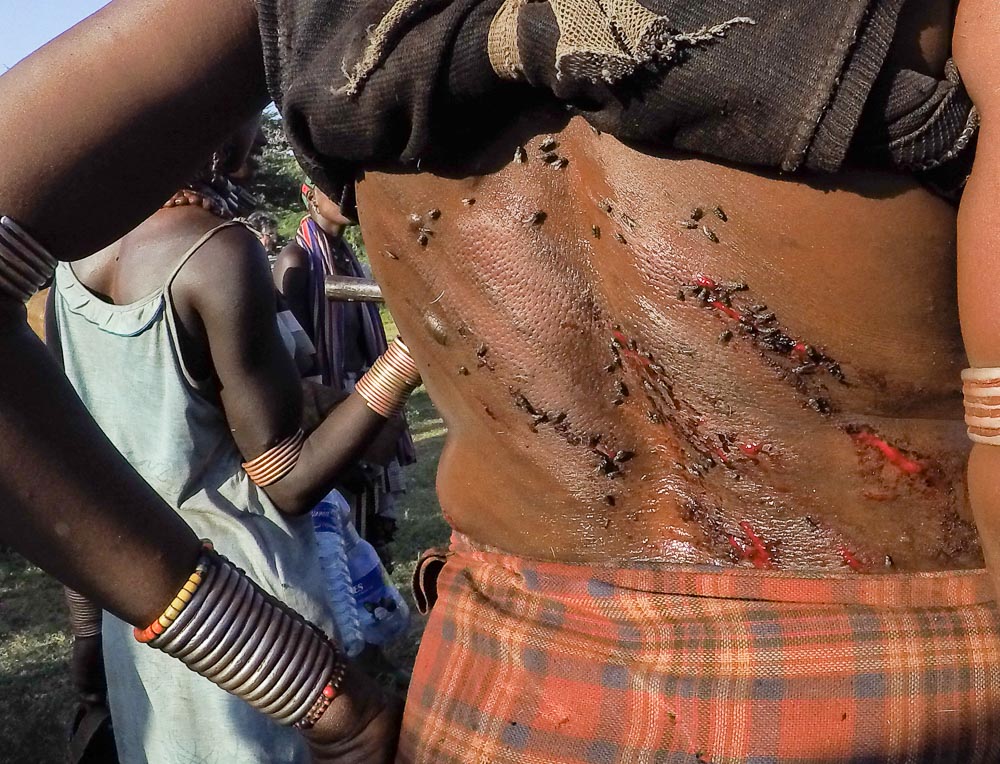
We were on to the main event.
Several bulls had been let into the field. About 8 bulls had been pushed, prodded, yanked and twisted so that they were now standing in a line. A naked man edged backwards, eyeing up the task ahead. His challenge was to leap up and run across the backs up the bulls without falling into the gaps between. If he succeeds, it marks his passing from boy to man.
He took a run up and jumped up to the first bull that reeled from the impact of the chap’s foot on its flank. He then skipped across the moving obstacles before losing his footing just short of the final bull. He repeated this 6 times. Everyone cheered and he was adorned with a garment for his neck. He was now a man…and so started 2 days of celebrations.
It was now sunset. Rokhan’s driver dropped us off the short distance to our campsite near Turmi where we finally met up with Tom and Eva at their Unimog. They cooked us a delicious pasta meal and we thoroughly enjoyed their company…and that ice-cold beer that we had suffered so much for.
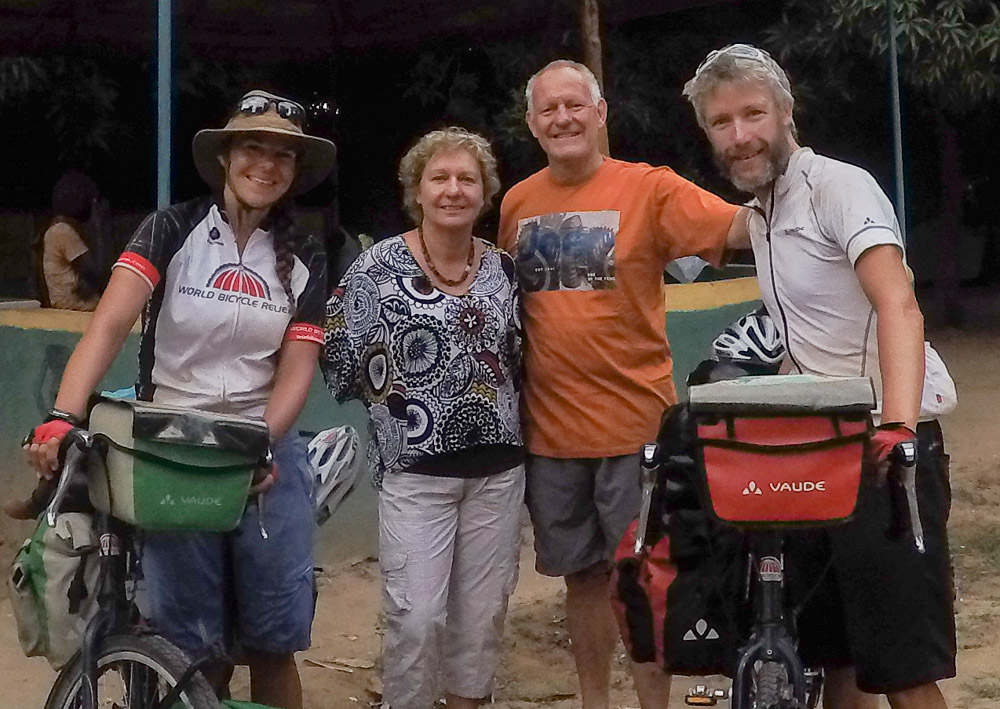
It was a relief that the 50km from Turmi to the final town in Ethiopia, Omorate was a gentle cycle on beautiful smooth tarmac. We headed to the immigration office where we had to guide the official, who was clearly drunk, through the process of stamping our passport with an exit stamp with the next day’s date. The process took a while because he couldn’t get his fuzzy head round the concept of our visa being valid from the ‘date of entry’ rather than the ‘date of issue’ which he was insisting was the case. He claimed we were in the country illegally and threatened to take us to Addis Ababa. We were there for over an hour before his desire to return to the bar took over and he finally stamped our passport.
Omorate doesn’t have anything to offer. Not even electricity. And we even struggled to stock up on food for our journey into Kenya. But we did manage to get a friendly chap to charge our Goal Zero Sherpa 100 power pack so we could ensure our GPS would work for the journey ahead.
We’d heard many tales from other travellers that crossing the bridge over the Omo river is an issue. Policeman guard it and insist that it’s closed, despite locals walking across it, forcing travellers to pay for a boat or dug out canoe across the river.
When we approached the bridge, we could see the police guards and, from the distance, they were waving us back. We continued and, just as we approached them, a big pickup truck thundered up on to the bridge from the opposite bank crossed over and passed us. There was no way the police could claim that the bridge was closed now. They made a cursory check of our passports and to our relief, we cycled over the bridge.
Once we were on the far bank, our challenge was to negotiate a confusing network of sandy tracks towards the Ethiopian army checkpoint then through the arid no-mans-land before getting to the Kenya border checkpoint.
This was hot, dry and the sandy conditions of the road made cycling impossible. The weight of our bikes, now even heavier with the weight of 10 litres of water each and food supplies for up to one week, cut straight through into the sand causing a few low-speed crashes.

We had to haul our bikes through the sand. It took us 4 hours to make the 29 kilometers from Omorate to the Ethiopian army checkpoint. The friendly squaddies offered us water and we relished the shade. But we had to press on.
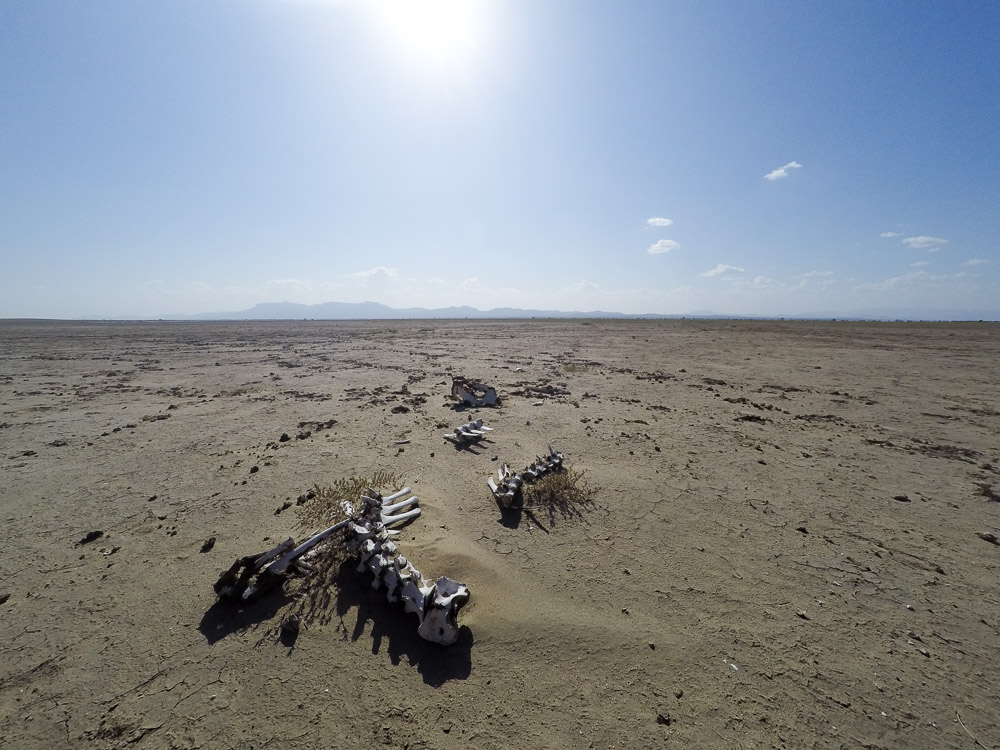
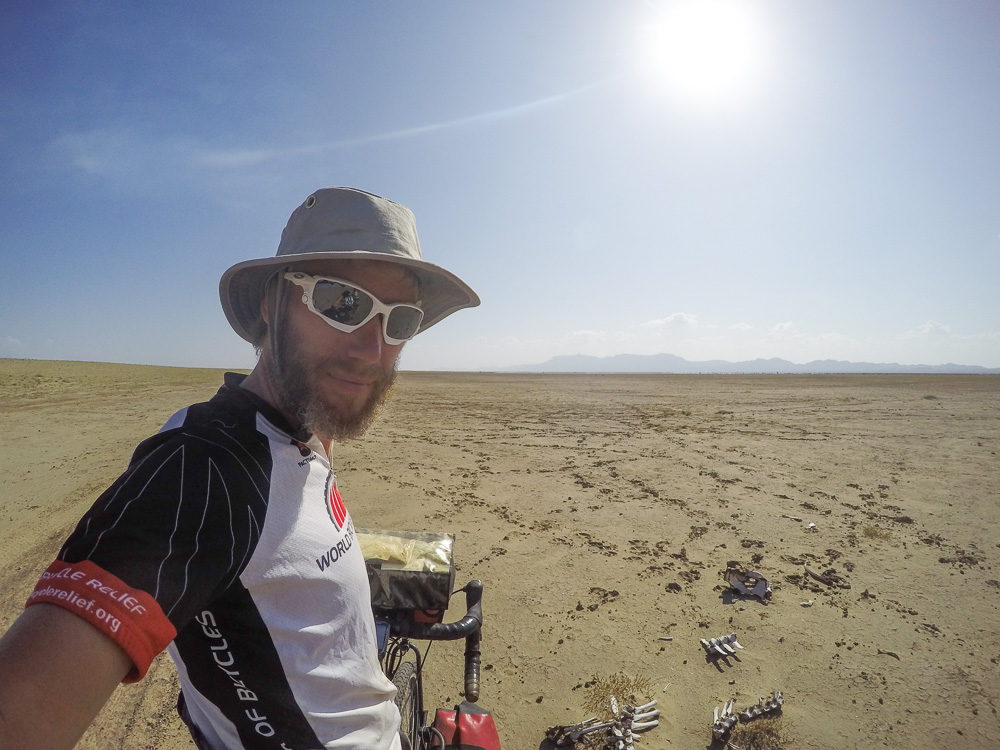
It took us a further 2 and a half hours to haul our bikes through the sand over the 7km between the Ethiopian and Kenyan border checkpoints. We arrived exhausted.
The Kenyan policeman took our details down in a book (we couldn’t get our passport stamped because it’s not an ‘official’ crossing) and invited us to pitch our tent at the police compound. Another policeman told us that the road onwards would improve and stamped his feet on the hard-packed surface of the police compound, suggesting that that was what we could expect from now on. By now it was 5pm. The sun would set in 90 minutes. We were knackered but decided to press on. It was just 10km to get to our intended destination.
Sadly, the policeman’s description of the road ahead was entirely inaccurate. Once again we were forced to dismount and heave our bikes through the sand.
As the sun went down behind the distant mountain, we were forced to call the day’s ride to an end – just 3km from our target destination. We camped in the bush amidst billions of mosquitos and insects. Later that night, I discovered that the flying sharks had attacked my back by biting straight through my shirt. Emily lost count at over 100 bites. Not great when we’re in a malarial area and aren’t taking prophylactics.

Since leaving Addis Ababa, we’d been on the road for 10 days straight – our longest period without a break. The terrain had been hilly. The kids were horrendous. We had rocks thrown at us several times a day. We’d been munched by mosquitos. The roads had petered out and turned into riverbeds. We’d had to haul our bikes through kilometer after kilometer of sand. The mercury topped 50 degrees on most days. All this had put a huge toll on our bodies and has triggered a few medical issues. We needed a break. We needed a refuge. And we found that just 3km up the road the next morning at the Our Lady Queen of Peace Catholic mission in Todonyang – the first town in Kenya.
We were greeted warmly by Father Andrew, pitched our tent under a tree and brought cold, crisp water by a charming chap named Cosmos. Father Andrew told us that the road between the mission and Lodwar was the same sandy surface we’d suffered.
It would have taken us 7 to 10 days to travel the West Turkana route by bicycle. And we would have had to haul our bikes through the sand and more dried riverbeds. Something we didn’t have the health to do. The next day, we strapped our bikes to the top of the 4×4 and joined Father Andrew (as he drove like a man on a mission) and friends for the incredibly bumpy and uncomfortable trip to Lodwar, where we are now. En route we saw a monument that marks the spot of the oldest skull to have ever been found. Turkana Boy.
We shall make up the miles we missed. In Lodwar, we’ll get ourselves checked out by doctors and speak to the police about the security situation on the road ahead. The long and lonely road between Lodwar and Kitale is renowned for bandits and tribal conflict so we need to get up to date advice on what to expect. Should we need to bypass this section we’ll make those miles up too.
Ethiopia has been an immense challenge that’s left us both utterly exhausted. It’s a beautiful country. But it’s incredibly difficult cycling over such terrain and, despite some magical experiences in the tribal lands of the Omo valley, enduring the constant ‘difficult’ interactions with the people. I’ve found the country has brought out an angry side in us at times. I’ve lost my temper of numerous occasions in situations where I’d normally be mild mannered. When rocks have been thrown at us by children I shamefully admit to returning a few of them with interest. It’s an anger that I’m leaving at the border. And, once we’re fit again, we’re both hugely excited about the journey ahead in Kenya and into Uganda where we expect to be cheered rather than jeered. And where a cold bottle of water is, hopefully, only a village away.
Walking back to recovery in the Simien Mountains, Ethiopia
/in Cairo to Cape Town, Kindness of strangers, London to Cape Town /by James DavisWe reached the Sudanese border town of Gallabat at 11am and found shade in the café nearest the border post. The incredibly friendly café owner refused to accept payment for the Cokes we’d plucked from the fridge and he even gave us a couple of bottles of water. We obviously looked in a bad way.
We then went through the border crossing formalities. First we visited the security department where the chap wrote our passport information down. We were then escorted to Sudanese customs where another chap wrote our passport information down in a dusty book. Then, we wheeled our bikes round the corner to another building which housed the Immigration Department. Once we’d filled out a form, handed over photocopies of our passports we received the stamp in our passports allowing us to leave Sudan.
We didn’t do so immediately.
We headed back to the café where we’d intended to spend our last Sudanese pounds. I raided the fridge for bottles of water and drinks for our onward journey but, once again, the café owner refused payment saying we were visitors in his country and he wanted us to leave with a good impression. We were just meters from the border with Ethiopia and it was, yet again, an outstanding last-minute example of the hospitality that we’d experienced throughout Sudan. Although, ironically, when he offered to change money he gave us a horrendous rate.
Once we’d been stamped into Ethiopia the next stop was customs. We were directed to what looked like a bus shelter where a couple of bored looking chaps asked us to empty the contents of our panniers.
The customs post was in a public area and people were milling round. I wanted to ensure the chap was a bone fide customs employee before he started rifling through our things but he couldn’t produce any ID. Instead, he stood up and put on a high vis jacket, insisting that this was sufficient proof that he worked for customs. In return, I reached into my pannier, took out my high vis vest and declared to him that I now worked for customs too. It raised a laugh…and a short delay as he went to find someone more senior to prove that this roadside shack was official customs.
The world changed once we’d crossed the border into the Ethiopian town of Metema.
The dusty high street leading up the hill from the border is lined with seedy bars and shifty looking folk – all looking to make a buck from whomever they could. We cycled slowly up the hill, witnessing a bar brawl on the way and debated whether the hostesses’ main employment was from bar work or employment of a more ‘behind-the-scenes’ nature. We read online that Metema was the centre of the people-smugglng trade.
We’d made the decision to take the bus to Gonder because Emily was unwell. We found the bus station and negotiated room on a bus for 100Birr (£3GBP) per person plus another 50Birr for each of the bikes.
Our trusty steeds were hauled on top of the Toyota HiAce minibus and strapped down with string. After a 2-hour wait for the bus to fill up, we departed Metema and clung on whilst we whizzed through the dramatic countryside towards Gonder – every clonk from the roof making us wince as we envisaged gears, disk brakes and frames being bashed with every pot hole.
If Metema was a shifty introduction to Ethiopia, then Gonder was the complete opposite.
After months cycling in the Muslim world it took a bit of time to get used to the things that we’d once considered ‘normal’. Smiling couples walked hand in hand. People enjoyed cool beers at roadside bars. Restaurants offered full menus with ‘farangi’ food: chips, pizza and spaghetti. The bread was raised…and delicious and the fresh mango juice was everything we had dreamt of whilst cycling in the desert.
The Muslim call to prayer was replaced by full Orthodox Christian services being blasted from the speakers of the nearby church. The Sunday morning service started at 2am and was still going strong at 8am.
Even the time in Ethiopia is different.
We’d read about ‘Ethiopian time’ before we arrived but thought it was something similar to Welsh: talked about but nobody knows anyone who actually speaks it. In fact, Ethiopian time is incredibly logical. The day starts at dawn. An hour after sunrise is 1 O’clock. 2 hours after sunrise is 2 O’Clock and so on until sunset, which is 12 O’clock. We had to make sure that any time given to us was ‘farangi time’ (meaning foreigners’ time).
We took a couple of days in Gonder to let bodies recover. And, with the cooler temperatures, great food on offer and large, comfy beds we were both fit enough for the next challenge: a 4-day trek in the Simien mountains.
We’d considered arranging our trip to the Simiens independently. It’s possible to do so but takes a few days to organize all the requirements: Transport, entrance fees, scout etc. Instead, we opted to let a professional take this pressure off us. And we’re glad we did.
Early in the morning (just as the Orthodox Christian service was finishing!) a minibus rocked up which contained our guide, Desu, a driver, a cook and an assistant cook. We picked up our scout in Debark, an hour’s drive away and then headed up the off road track to the mountains.
It’s a requirement to have a scout accompany any visitors to the park. The scout’s job is to carry a gun and shuffle behind the group for ‘protection’. There’s nothing, actually, to protect against (either people or animals) so it’s widely acknowledged that the park’s insistence on an accompanying scout is for job creation. It transpired our scout was actually a local farmer and scouted to top up his meagre wages – something we were happy to facilitate.
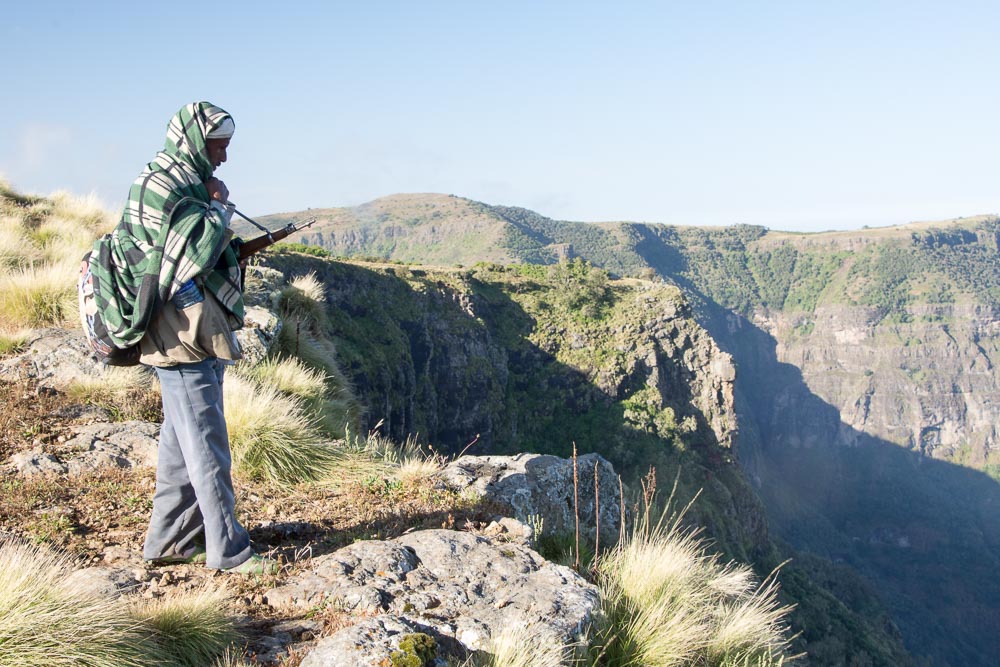
Our scout kept watch over us for four days
We laced up our Zamberlan trail shoes and, over the next 4 days we were treated to views like we’d never seen before. The paths clung perilously close to the cliff tops. And afforded us stunning views across the Ethiopian Highlands. But one small slip could have had us plunge thousands of feet off the sheer cliff face.

Trekking the Simien mountains: The World’s best ridge walk?
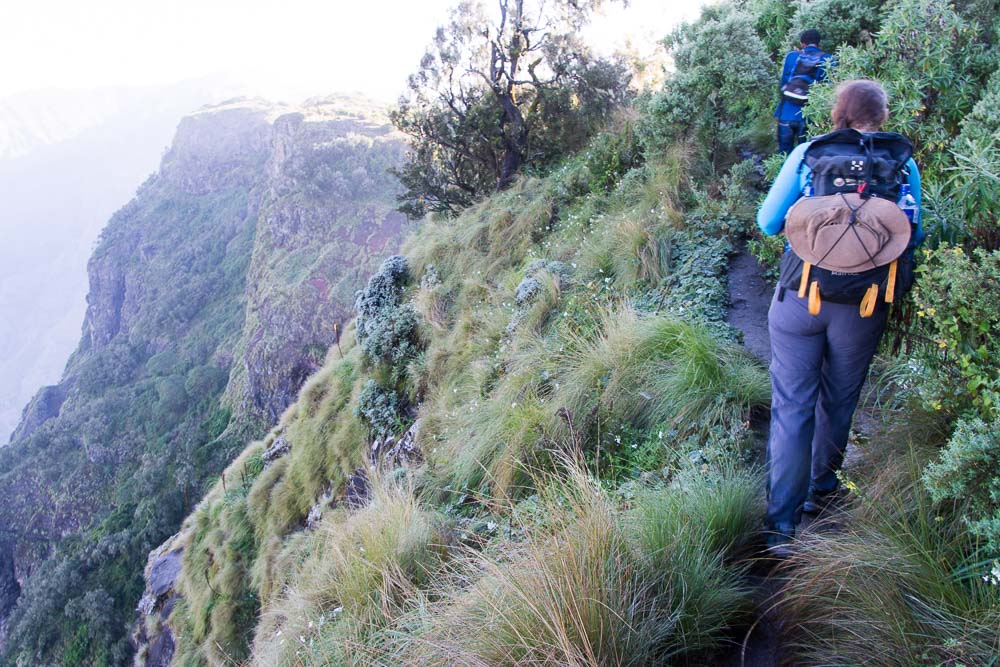
The path clung to the cliff face
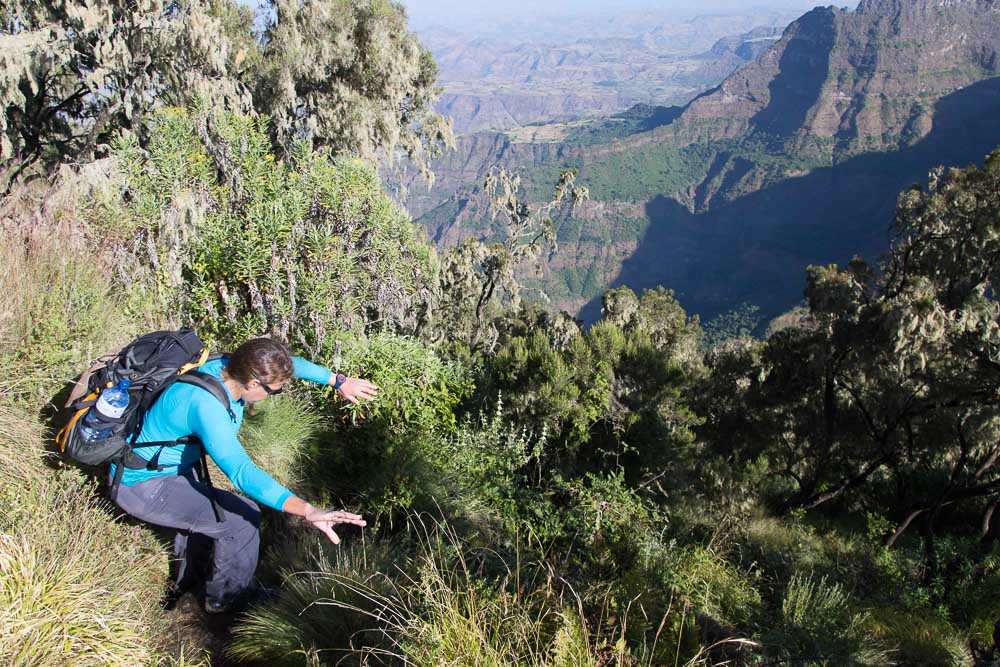
Don’t slip there!

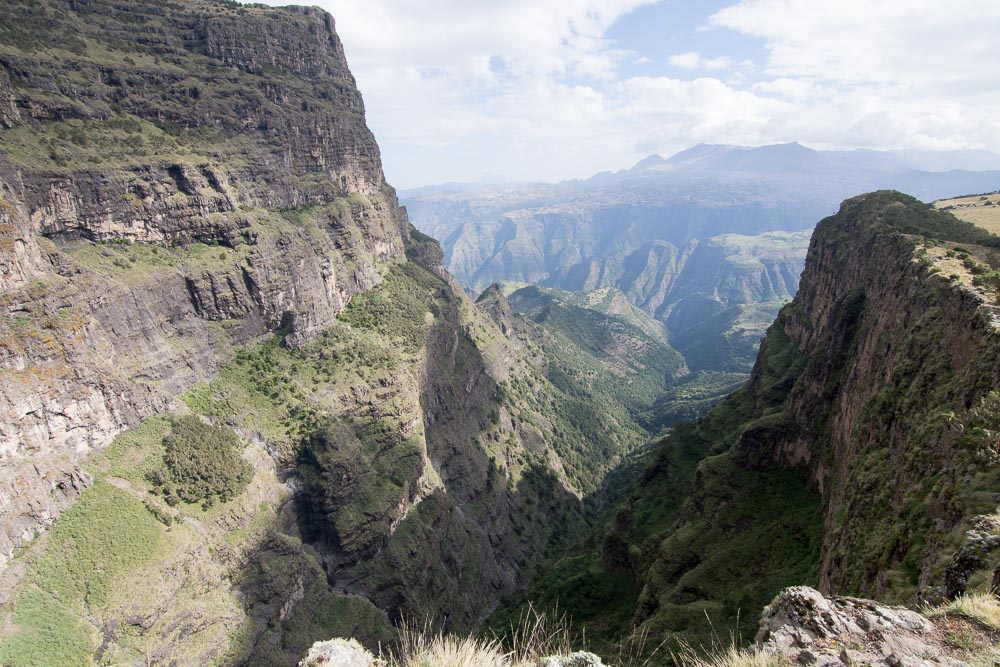
We were lucky to see some amazing wildlife too.
Friendly Gelada monkeys grazed (yes, they eat grass!) on the grassy hillsides. We learnt that, because Gelada monkeys are forever in the seating position as they graze, the females display their fertility through their pink chest plate – unlike other types of monkeys whose bums turn red.
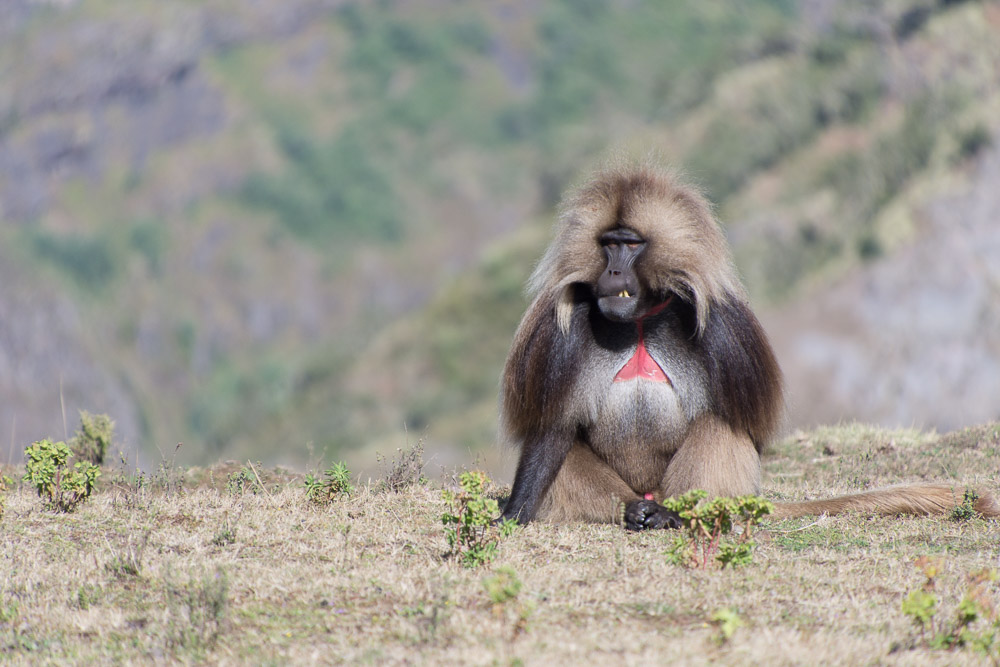
Gelada monkeys grazed on the hillsides
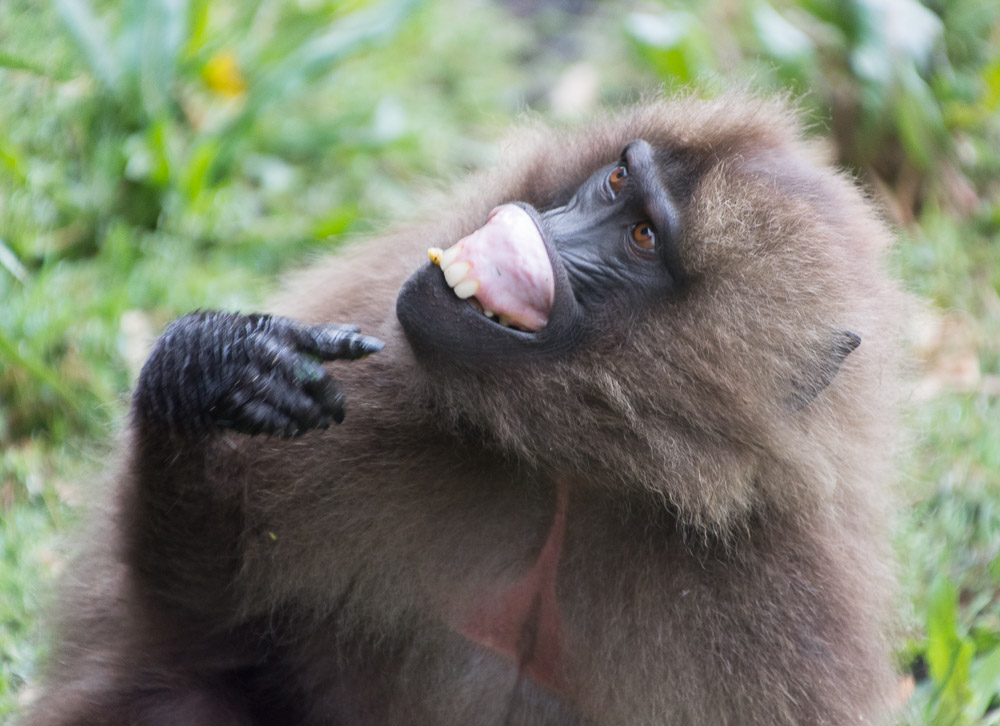
Gelada monkeys have ‘rubber lips’ which they retreat to reveal their teeth when they’re getting tetchy
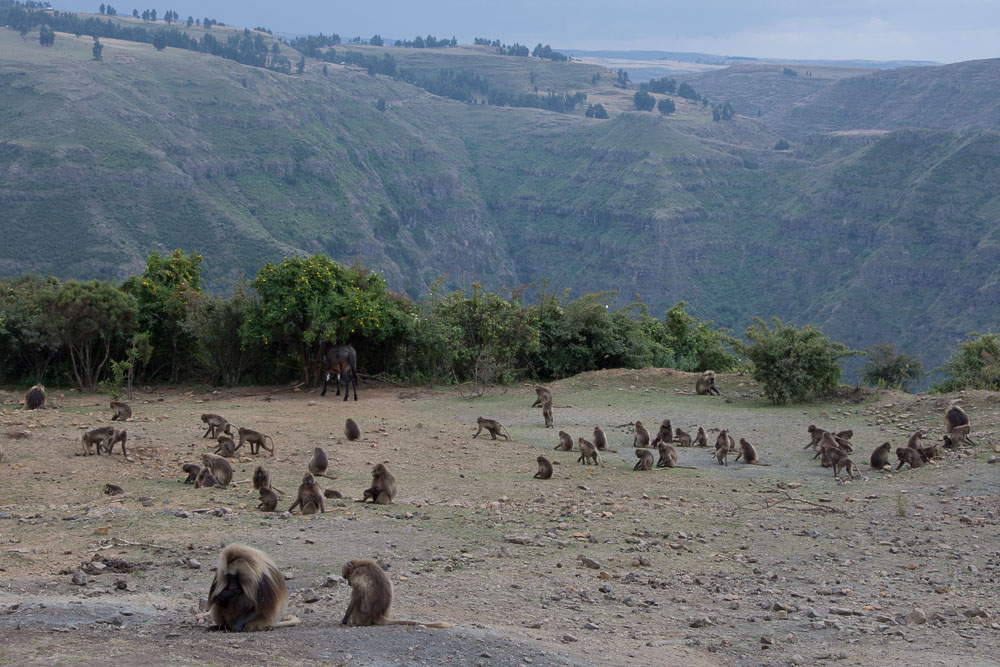
Gelada monkeys roam the hillsides
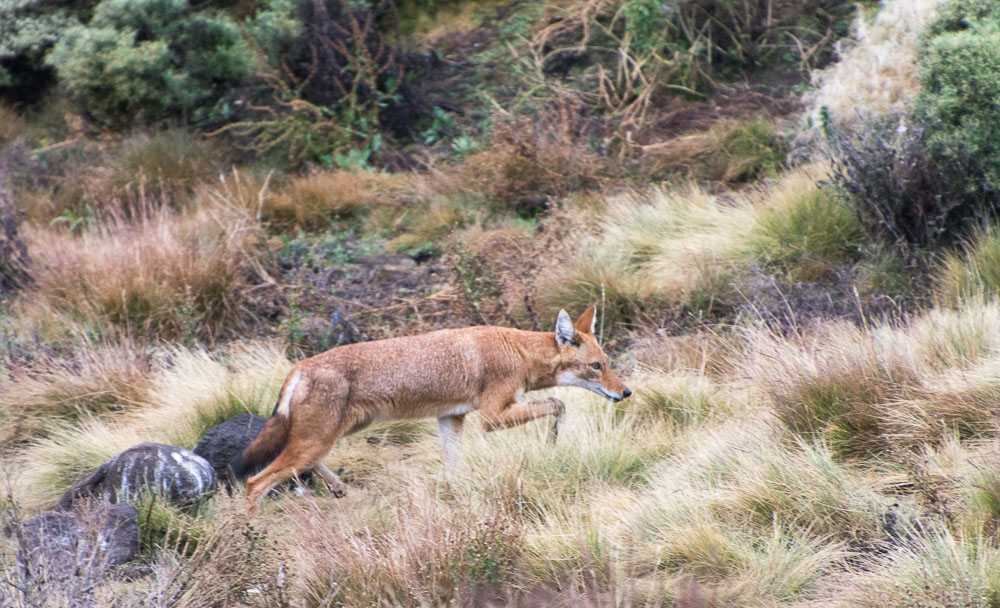
An incredibly rare sighting of an Ethiopian fox hunting for mice
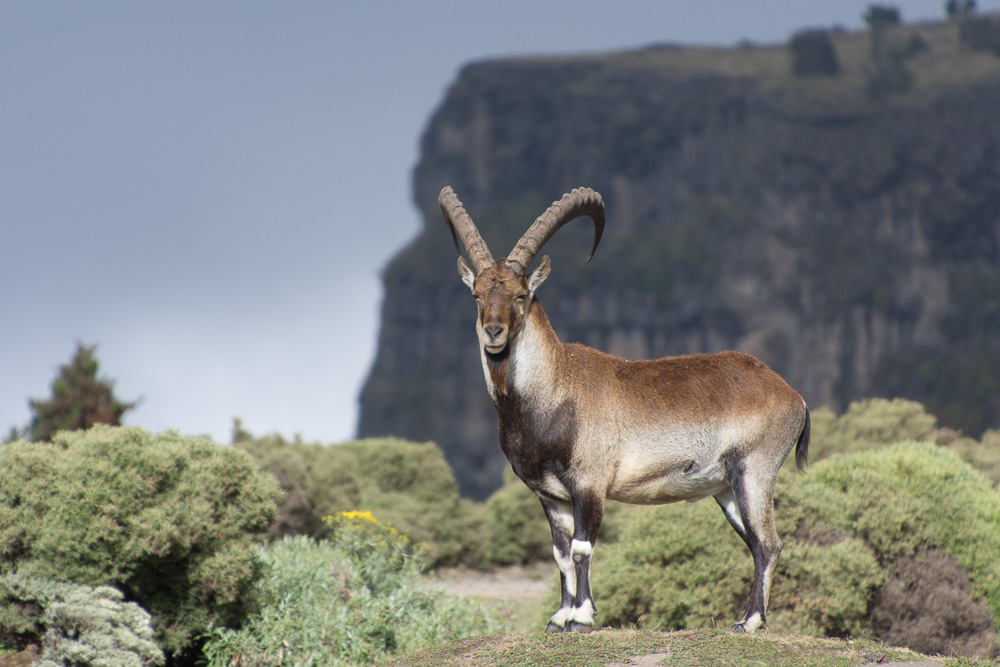
An ibex stands proud against the Simien mountains in Ethiopia
Additionally, we saw several ‘bone-breaker’ vultures. The diet of these huge birds consists of the bones of dead animals. If the bones they find are too big to swallow, they’ll pick them up and drop them from a huge height into the ravine below where they’ll weaken on impact with the rocks far below. They’ll repeat the process until the bones are of an edible size.
After months of pitching our own tent, it was pure luxury for us to arrive at camp after our days’ treks to find the tent pitched and flasks of tea and coffee ready for us. We shared popcorn with the ravens and watched the sunset from our high altitude camps – on the evenings it wasn’t tipping it down. In fact, we experienced our first rain since Romania over 3 months ago!
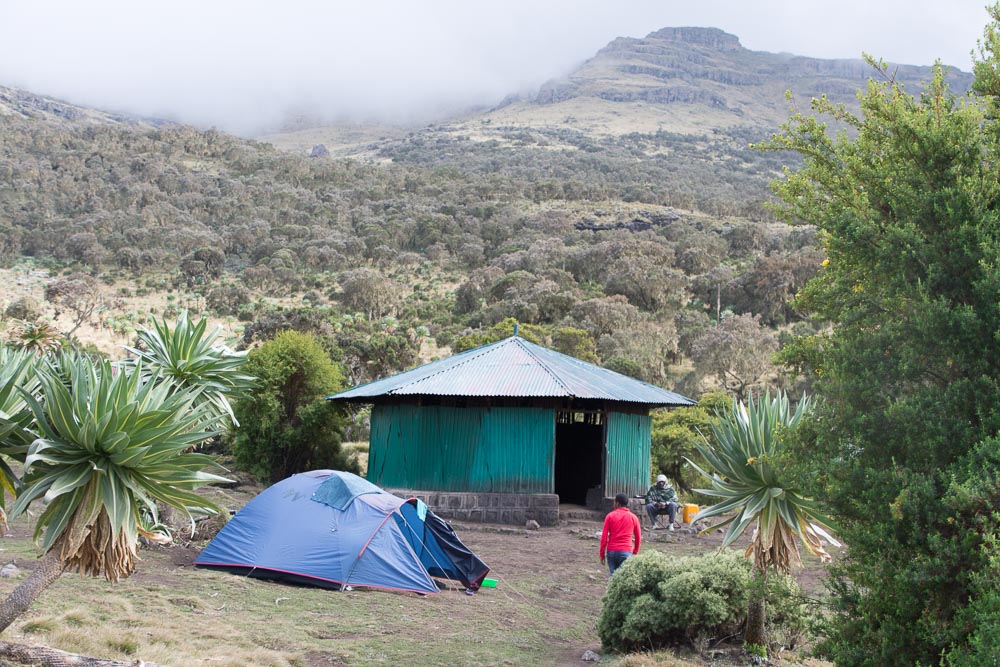
Although we missed the quality and spaciousness of our Vaude tent, we were happy to have a tent pitched for us each night
Our chef and assistant chef worked wonders too. They produced tasty, hearty meals from fresh ingredients. Our chicken meal could not have been fresher. In fact, I volunteered to help the assistant chef ‘prepare’ the live chicken for dinner. I held the feet whilst he used the knife.

Getting ready for a feast by the roaring fire
The temperatures in the Simien Mountains were in complete contrast to the 50-degree heat of the Sudanese deserts from where we’d come. We huddled round the fire to keep warm whilst eating and nighttime temperatures went down to freezing.
Although we were between 3,500 and 4,000 meters, the hiking itself wasn’t too strenuous and, with the aid of great food cooked up by our chef, we were able to get our bodies back to normal, ready for the cycling ahead.
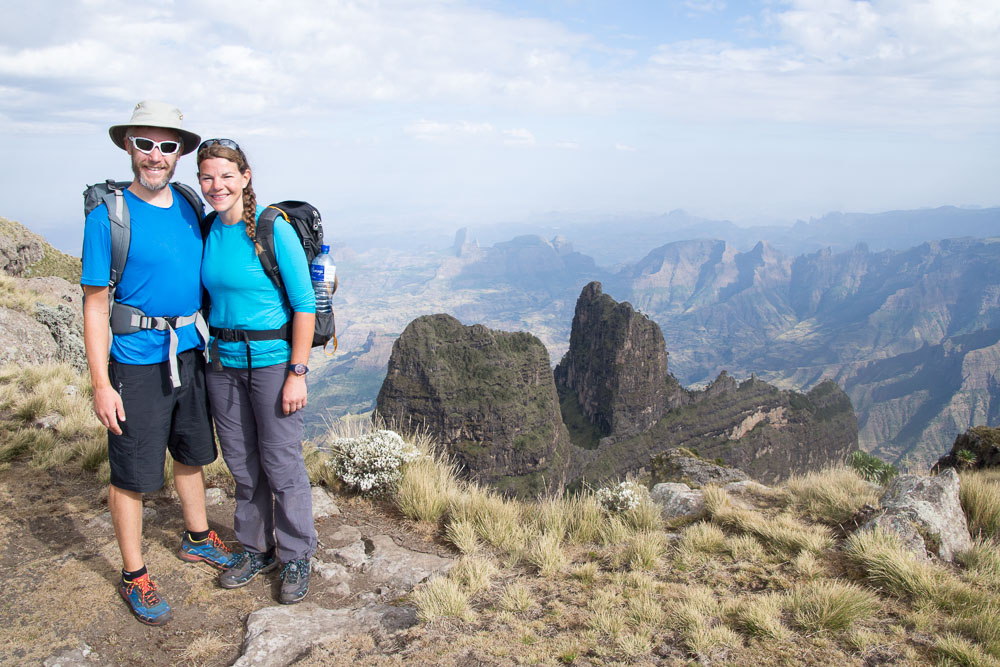
The Simien mountain views were stunning
On our last morning in the mountains we discovered blood spots on our sleeping bag liners and bites on our bodies. Back in Gonder we inspected our sleeping bags to find we’d picked up bed bugs from the bedding that had been provided on the trek. Not content with letting them fester, we’ve delayed our departure from Gonder to get the critters dealt with.
All being well, we’ll be back on the bikes tomorrow (Friday) as we take on the 800km cycle for Addis Ababa. A ride that’ll certainly introduce us to rural Ethiopian life. We just hope we won’t get stoned too much by the small children we’ll encounter: a real hazard of cycling in these parts. Please follow our progress on our live GPS tracker.
Don’t forget to subscribe to our email alerts so you’ll be the first to know when we’ve published a new blog post. We’ll never share your details. Ever.
Cycling from Khartoum, Sudan, to Gondar, Ethiopia
/in Cairo to Cape Town, Kindness of strangers, London to Cape Town /by Emily Conrad-PicklesA lot has happened in the past week. Not all of it good. Our stay in Khartoum was extended after I endured two separate stomach bugs but, once rested and all systems were back up and working properly, we set off on our 5-day ride to the border with Ethiopia. The plan was to cross at the Gallbat/Metema border before heading into cooler climes and mountain air, something we were both excited but apprehensive about.
The ride out of Khartoum was quieter than we expected and, although we were cycling on a main road, we had plenty of space. Actually in Sudan the lorry drivers are incredibly patient and will wait their turn to pass you if there is oncoming traffic and most will wave and beep their horns at you. The buses however were another story – coaches whizzing across the country at an extraordinary pace pass you with far less patience and on many occasions forced us off the road.
On our first evening after leaving Khartoum, we’d stopped in a small town to pick up some vegetables and a cold drink – we have often found it hard to pay anything for vegetables in Sudan as the market vendors continue to tell us that we are their guests and refuse payment! Cycling out of town to find a spot to camp we were stopped by a man on the road, “Welcome! Welcome! Where are you going?” which is perfectly normal in Sudan however he then added, “But where will you sleep?” – so we stopped to chat and before we knew it our new friend, Ihad, had invited us to spend the evening with his family in their compound.
Both exhausted, we kindly accepted his invitation, as we were keen to learn more about daily family life in Sudan – and we were not disappointed. Ihad lives with the majority of his extended family (25 or so) in a compound just by the Blue Nile and we spent a fantastic evening meeting his children and his two sisters’ children and shared a meal with his immediate family.
By now, it was nearing 9.30pm and way past our usual bedtime so we were starting to make our excuses to get to bed when I was ushered away by his wife and sister to go and see where we were sleeping. They, however, had hatched another plan and I was whisked away into a room where they wanted to give me a “Sudanese bath”. Now, I know I was probably pretty stinky but I was not expecting what happened next. First, I was given a nightie to wear and told to hover over a scented fire and then before I knew it, they were lathering my body in a sort of body scrub which was rubbed into my arms and legs until most of my skin had fallen off. I have to be honest; I found the whole thing a little traumatising as I sat there trying to be polite, but at the same time slightly overwhelmed by my impromptu scrub! I just about managed to convince them that they shouldn’t put a bottle of olive oil in my hair, as it would run into my eyes the next day. I was then given a traditional Sudanese outfit to go and greet James before bed!
The next morning we were invited to a breakfast celebration as Ihad’s niece’s 2-year old son was getting circumcised. So, after tea and biscuits, we made our way across the town to the party.
Ihad had been to the market early to buy a lamb to feast on. Thankfully, by the time we arrived, the lamb had already been slaughtered and the circumcision had been performed – both tasks James had been willing to perform with our Swiss Army Knife.
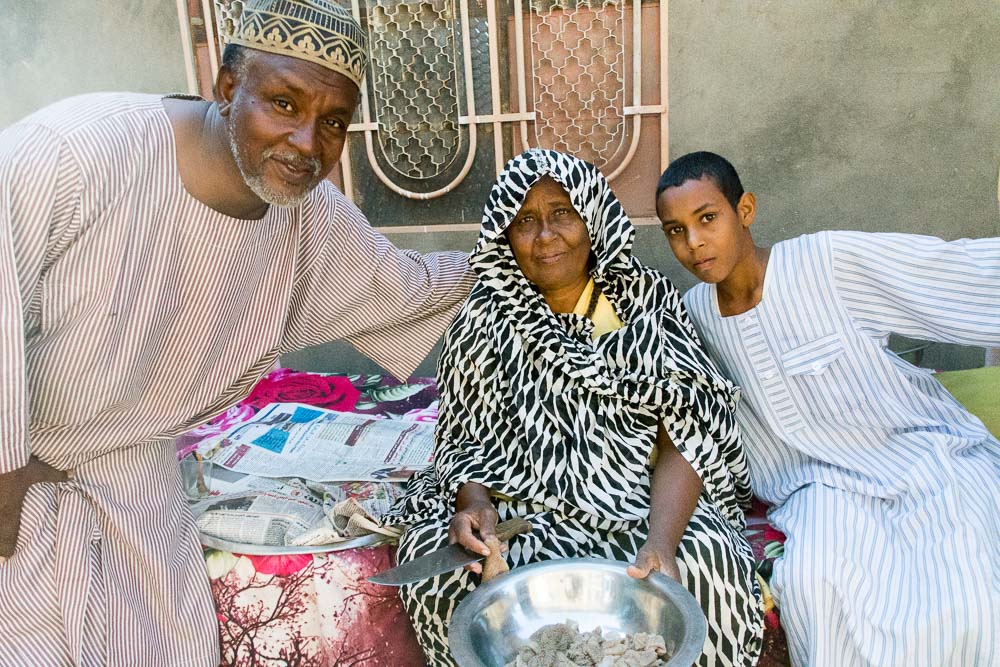
Ihad, his mother and son. Ihad’s mother was preparing the sheep’s stomach for the celebratory breakfast.
Sadly we couldn’t stay for too long as we needed to get on the road but the Sudanese hospitality was amazing and we felt very lucky to have been invited. Although we couldn’t help notice the forlorn look on the face of the poor lad who’d had the circumcision as he lay on a bed recuperating quietly whilst his extended family celebrated around him.
Back on the road, we made our way to the border where we were due to arrive on Monday afternoon – 3 days ride away and around 340km. The landscape was beginning to change. It’s harvest time in Sudan and the farmers were busy in the fields and as we passed through smaller villages we started to notice a change in the people too with lots more shouting from the sidelines! The conditions were tough – a fierce cross wind had rejoined us and the temperatures were soaring once more; our Garmin actually hit 58 Celsius at one point but nothing we were not used too.
But then something changed. At the end of the next day I started to feel ‘not quite right’. We put it down to dehydration and stopped a little early for the day to rest up and drink lots of delicious warm filtered water! For the next two days, things didn’t improve; I was managing around 30 minutes of cycling at a time before having to stop to sit down off my bike, it was like someone had turned off the generator, there was nothing left. We took the decision to have much shorter days, stopping for water and Cokes whenever we could and it was a matter of taking things one step at a time.
Just to add to the fun, I left my wallet behind in a small town where we had stopped for a few hours so that I could rest which left us in quite a tricky situation. We returned 20 minutes later but it had gone. We were still a couple of days from the border and faced with the prospect of no money for food and most importantly, in the state I was in, for sugary drinks. An exceptionally kind man came to ask us what he could do to help us although short of getting the wallet back, there was not much that he could do.
Panic set in – not because of the contents of the wallet as we have always been careful to only keep one credit card in there and limited cash – but due to the lack to cash and the seemingly never ending road to the border ahead.
What followed was unexpected and quite amazing – the kind man turned to the dozens of people crowding round us and organised a whip-round asking people to spare some money for us. He apologised on behalf of his people and handed us around 70 Sudanese Pounds (around £7) – which was more than enough to buy enough bread, vegetables and eggs to keep us going! We have been touched by the extraordinary generosity of the people here and will be forever grateful for his help.
Another day had passed and progress continued to be slow. After another extremely hard day, we camped around 25km from the border to Ethiopia, which we made the next day by around 11am after an early start.
An incredibly hard decision needed to be made. We could continue to cycle, knowing full well that the mountains were right in front of us, knowing that we were not going to pass through any decent towns until the city of Gondar, 180km across the border, or we could take a bus.
We both agreed before we left home that we were not going to take a bus unless it was an emergency, our bikes were broken, the road was completely impassable, security risks or for health reasons. And I’ve never been one to quit – no matter tough it is – we set out to cycle to Cape Town and raise money and awareness for an incredible cause and did not want to have to stop. However, I just did not have anything left in my body whatsoever. Every time I tried to cycle I thought I was going to fall off my bike and I have lost count of the tears I have shed in the process and so, regretfully, once we were over the border into Ethiopia, we took a bus to Gondar where we are now resting up in a little hotel (L-shaped hotel) which has warm water and a bed. I’ve no doubt all will be right as rain within a couple of days once I have rehydrated and I’ve managed to eat some more and we can continue our adventure in the Ethiopian Highlands.
One thing is for sure; I could not have got through the past few days without James and his tireless support, words of encouragement, patience and love. I feel bloody awful that I have forced us onto a bus, but I know that it was for the best and now it is all about a focus on recovery and regrouping.
Getting a bus: James’s perspective.
When we set off for London on 12th July, the aim was to cycle all the way from London to Cape Town as ‘purely’ as possible. By pure, I mean that we would only be forced off our bikes if absolutely necessary.
Yesterday we got a bus. And I want to explain why we did so.
Sudan has been relentless. Sure it’s been flat. But the lack of gradient only goes some way to make up for how tough it’s been.
Imagine cycling the equivalent of Land’s End to John O’Groats through barren desert with only 4 towns of any significance en route, no shade, very limited water resources and battling against ferocious winds that whipped up sand that stung the skin. We arrived in Khartoum shadows of our former fighting-fit selves.
Add stomach bugs to the mix. I was able to get over mine by the time we reached Khartoum but, throughout the stay in Khartoum, Emily was unable to rest and rehydrate as she would have liked.
We extended our time in Khartoum but the following days were the toughest we’d experienced. Emily wasn’t in a great place so progress was slow and we dramatically reduced our daily distances. Where before we were cycling 120km per day we were now barely managing 60km. Emily had to stop every 2km or so and cower under thorn bushes for shade and retched at the roadside.
Emily is not a quitter. A GB (age group) triathlete and Ironman competitor, her fitness is not an issue. She’s also been whacked by a few lacrosse balls in her time so knows what real pain is.
One of our stated objectives before we set out was to ensure the expedition was safe. The remote Sudanese plain is not the place to get ill. It was 500km back to Khartoum or 200km ahead to Gondar. Staying put was not an option. Firstly, we were far from medical help. Secondly, even resting in a stifling tent, which in itself can be hotter than outside, was not an option.
Taking the decision to get a bus was painful. But not as painful as seeing Emily suffer and deteriorate visibly without showing any signs of recovering.
Taking the bus meant we missed a 197.5 km section of sealed road which had an ascent of 3,452 meters and descent of 1,947 meters. We’ll be sure to make this up when we get back on the road, hopefully in a few days’ time.
Crossing the desert from Aswan to Khartoum
/in Cairo to Cape Town, Kindness of strangers, London to Cape Town /by Emily Conrad-PicklesThere are two ways to travel independently from Egypt to Sudan. The first is to take a ferry from Aswan to Wadi Halfa and the second is to cross the recently re-opened land border. Neither of which you can cycle (unless, of course, you are Mark Beaumont setting World Records with a full police escort, a lightweight bike and the ability to cycle 300km in one day!). The bus company was not keen to take us with our bikes so we opted for the well-travelled route by ferry.
Our extensive research told us that we needed to be prepared for this trip – we had read a number of blogs where travellers had been refused ticket sales and bumped off boats due to overcrowding even though they had a ticket, so we were keen to ensure that this was not to happen to us. Once we had our precious Sudanese visas we headed to the ticket office tucked away on an Aswan back street and asked for two 3rd class tickets. “Sorry, no 3rd class tickets available”. First class gives you a tiny cabin, second class entitles you to a chair and third class is deck space only. Since we were happy to sleep in our own space on deck on our sleeping mats third class was more than good enough. But not for foreigners it seems. Eager not to cause any fuss, we bought two second-class tickets for the weekly ferry on Sunday.
We got ourselves packed up and ready to go, bought enough food and water for a couple of days and alarms were set for 4am ready to cycle to the port. You see, we’d been warned that we’d need to arrive really early to get to the front of the queue to ensure we got on the boat (one blog we had read mentioned a queue of over 100 people by 6am). So, after practically no sleep we made the one-hour ride through Aswan’s dusty back streets in the dark and made it to the port by 6am. We arrived to find a ghost town. Were we in the right place? Turns out we were so we set up camp by the gate in time for it to open at 9am, bought some tea and did what us Brits do well, formed an orderly queue all by ourselves. It felt a bit like we’d arrived to start queuing at Wimbledon a week early by mistake.
Before long, fellow travellers did start to arrive, with lorries laden with fridges, furniture, fruit & veg and many more household possessions. Still, not nearly as much as we were expecting. Finally the gates opened and the fun started. No less than 10 stages of bureaucracy and border control later, taking at least a couple of hours, we were at last free to get onto the boat. We whizzed onto the boat keen to get a good spot on deck only to find that we were the only people on the boat! Where was everyone? Still feeling a little like we had perhaps got onto the wrong ferry, we set up camp under the life rafts (the only place to guarantee shade all day) and went to sleep for a couple of hours. Around 6pm, once the boat had been fully loaded, we set sail for Sudan, although the deck was still pretty much empty.
After a very cold and windy night, the boat docked at Wadi Halfa around 10am the next morning and before we knew it, we were cycling in Sudan!
Exhausted from two nights without sleep we decided to spend the night in Halfa. We checked into a lokanda, the local name for a budget guest house (at $3 a person, it was a revolting as you might imagine and I wasn’t too sure they were that keen on having me there either). We needed to register with the police on arrival in Sudan, pay our entry fees as well as register for permits to travel outside Khartoum which took some time but was all done at the police station. Next stop was to get our photography permit which turned into a two hour wild goose chase as we were sent from one end of town to another a few times. Finally we found the right place but the man in charge was not there so he told us over the phone not to worry about the permit…we have not had any issues to date in Sudan without this permit and have subsequently picked one up in Khartoum.
From Wadi Halfa we took the road to Dongola, which tracks the Nile most of the way. The wind was behind us and we managed our longest day yet (170km) before wild camping amongst piles of bat poo in a disused building behind a water stop.
In Sudan, you can find water pots alongside the road relatively frequently to allow people to fill up with water – which is vital in the extreme summer heat when temperatures hit around 55 Celsius most days. We’d timed our entire trip to ensure we did not endure these sorts of temperatures and although we did have one day when the Garmin told us it was 50 degrees, it has mainly been between 32-40.
The road to Dongola was very much the same for the next couple of days, although the wind was not quite so favourable. Along the road were small Nubian villages and mining towns where people were so incredibly kind and welcoming. We had heard how friendly Sudan is and it has been amazing meeting so many lovely people. If you stop by the side of the road and someone sees you, they will immediately come and shake your hand and say you are welcome before leaving you to your own business.
We stopped over in Dongola in a small guesthouse and stocked up on supplies before our first desert crossing to Karima, which would take two days. We had plenty of food and enough water with us however, we were now heading southeast and the wind had picked up again blowing into our sides, slowing us down considerably. We’d had our first stomach upset and when, by4pm, we’d still not passed any water stations, tensions were rising somewhat at the prospect of having to ration our water until the end of the next day. We had just about enough with us, but it was going to be tight. Around 5pm we saw what we thought was a building in the distance…praying that it was not a mirage we steamed on ahead to check it out and, to our huge relief, we discovered there was a well and a couple of men living in a big concrete house. We were duly given as much water as we could drink, some dates and offered a bed inside for the night which we accepted without hesitation!
The next day was 120km to Karima, a town famous for its pyramids and home to Jebel Barkal, the southern most point of the Egyptian empire. Along the way, we met our first overlanders! Libby and Paddy and their two young girls were taking a year to drive from Cornwall to Cape Town – it was so lovely to see such friendly English people (the first English people we had seen since Cyprus!) and hear about their adventure.
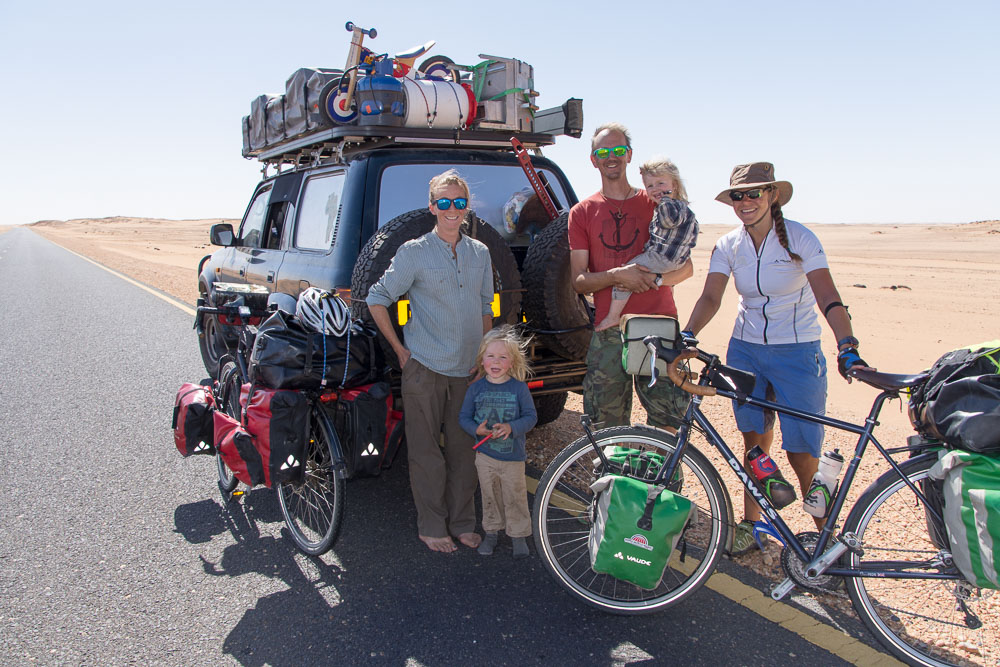
It was great to meet Libby, Paddy and their lovely daughters driving all the way from Cornwall to Cape Town
We mentioned that we were going to wild camp at the Nurri pyramids so we tentatively agreed to meet them later on. The day got the better of us both – the solitude of the desert and driving cross winds were exhausting and we rolled into Karima around 4pm and found somewhere to buy a coke and recharge. We had another 20km to our camp spot and just enough daylight to get there so we set off, excited at the prospect of camping at the pyramids and chatting some more with our new English friends. Unfortunately this was not to happen. Our route took us on a short cut through the town that ended up on a track with deep sand that made pushing our bikes painfully slow and exhausting so after 30 minutes we agreed we were just not going to make it and should fill up with water and find a camp spot. As if out of nowhere, we found a set of water taps and just beyond was a large shelter made from palm trees – a perfect place to camp out of the wind and out of sight! Just as we were setting up our tents two big 4x4s turned up and some extremely charming Sudanese men wanted to check that we were ok! They were on their way to prayers in town and after we assured them that we were fine and had an enclosed tent so no scorpions could get in they pressed on – but ensured that they checked in on us on their way back home! Such has been the welcome we have enjoyed almost everywhere in Sudan!
Once our tent was up and we’d washed, we sat in our chairs to relax for a bit before making some delicious rice and tinned beans. It was only then that we realised that we had accidentally camping right outside the tombs and pyramids of Jebel Barkal just in time for sunset! So, we may have missed the pyramids we were aiming for but we had a lovely surprise! We hope we might bump into Paddy and Libby again on the road as true to their word, they were waiting for us at Nurri Pyramids, just such a shame we never made it there.
From Karima it was time to do our second desert crossing to reach Atbara – this time the Bayuda desert – which would take us 3 days. Unsure what we could buy on the road, we stocked up with enough food for the duration and took as much water as we can carry (around 12 litres each).
It was an incredibly tough three days with a crosswind with us for almost the duration limiting our speed to 12-15kpm most of the way.
We were still having to pinch ourselves though to remember how much we had been dreaming about cycling across a desert and here we were – living our dream (it would be boring if it was easy right???!).
On the second night it was James’s turn to have a stomach upset which left him drained and exhausted for our final day on this stretch – but all was good, it was just 100km to Atbara we could get through it. Not so fast. Overnight a mild haboob had started brewing and, although it was not as bad as some of the storms we have heard about, cycling for an entire day with sand blowing into your face and frankly everywhere else made for a thoroughly miserable and incredibly exhausting day on the bikes. Of course in hindsight we can now look back on it with a smile and put it down as one of our more adventurous days!!
From Atbara we cycled a further three days to Khartoum along a much busier road carrying trucks to and from Khartoum and Port Sudan. Our first night was spent wild camping at some more pyramids – this time the Pyramids of Meroe – the ancient tombs of the ancient Nubian Kings and Queens of Meroe. Meroe was the capital of the Kingdom of Kush and it is thought that these pyramids are over 4,600 years old. Sadly an Italian explorer called Giusepe Ferlini destroyed many of them in a fruitless search for treasure and, although some are being reconstructed, we were shocked at how unsympathetic the reconstructions are. We’ve since learnt that hundreds more pyramids are being discovered every year here in Sudan and it is thought that there are more pyramids in one small section of the northern Sudanese desert than there are in the whole of Egypt! We felt hugely privileged to be able to enjoy these pyramids to ourselves and have the opportunity to camp just behind them and watch the sun go down. All that we were missing was a gin and tonic!
Finally, after 11 days on the go (our longest stint yet without a break) we arrived in Khartoum, somewhat worse for wear. We are extremely lucky be staying at KICS, the Khartoum International Community School and to be hosted by Nigel, Natasha and George (Nigel is the school Principal). I’m not too sure what Nigel thought when we arrived looking a little bit like shrivelled up desert prunes covered in sand dunes! After a shower and some food, we started to feel a little more like human beings and enjoyed our first night in a comfortable bed for some time!
We feel very lucky to be staying here at KICS – thank you so much to the incredibly lovely Winnard family for making us feel so at home (and Natasha we are so sad you could not be here too). This school is extraordinary. Both James and I have both decided we would like to go back to school here and start our education again. Nigel’s philosophy on education is inspiring and the children passing through his school are very lucky. We’ve enjoyed meeting and chatting to many of them during our stay.
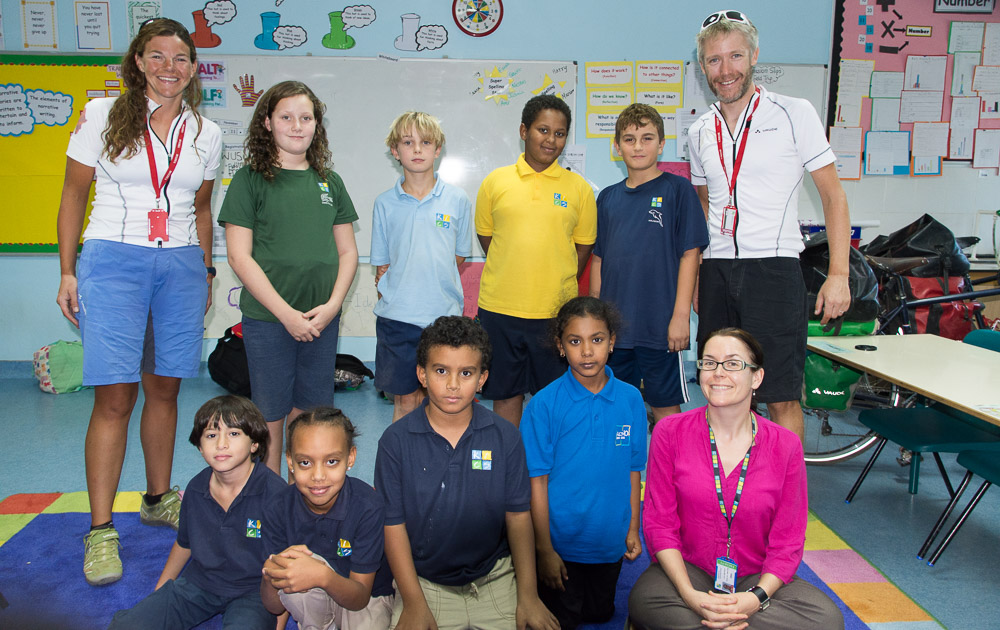
It was our pleasure to meet the Primary Student Council at Khartoum International Community School (KICS). They had some great questions and we were able to tell them about the @powerofbicycles
So, Ethiopian visas in hand, we are getting our kit together to hit the road once again with around one more week in Sudan, we should arrive in Ethiopia by the end of the month. Then life will change as we head into the mountains. Eek.
If you’ve enjoyed reading this blog post, please donate to World Bicycle Relief. Every penny goes to the great work the charity does in Africa – not to fund our expedition in any way.
Cycling Egypt: From Cairo to Aswan by bike
/in Cairo to Cape Town, London to Cape Town /by James DavisCycling Jordan’s Dead Sea to Madaba ascent
/in London to Cape Town /by James DavisToday I decided to give Emily a birthday treat by setting the challenge of climbing 1,600 meters from the Dead Sea to Madaba; achievable on paper. Much, much tougher in reality when faced with a 40km climb that was consistently steeper than anything we have tackled on this trip so far. Throw in the blazing sun, no shade, 42 degrees on the thermometer and nowhere to fill our bottles (other than the 4 liters each we’d brought with us) and it made for a very, very tough day.
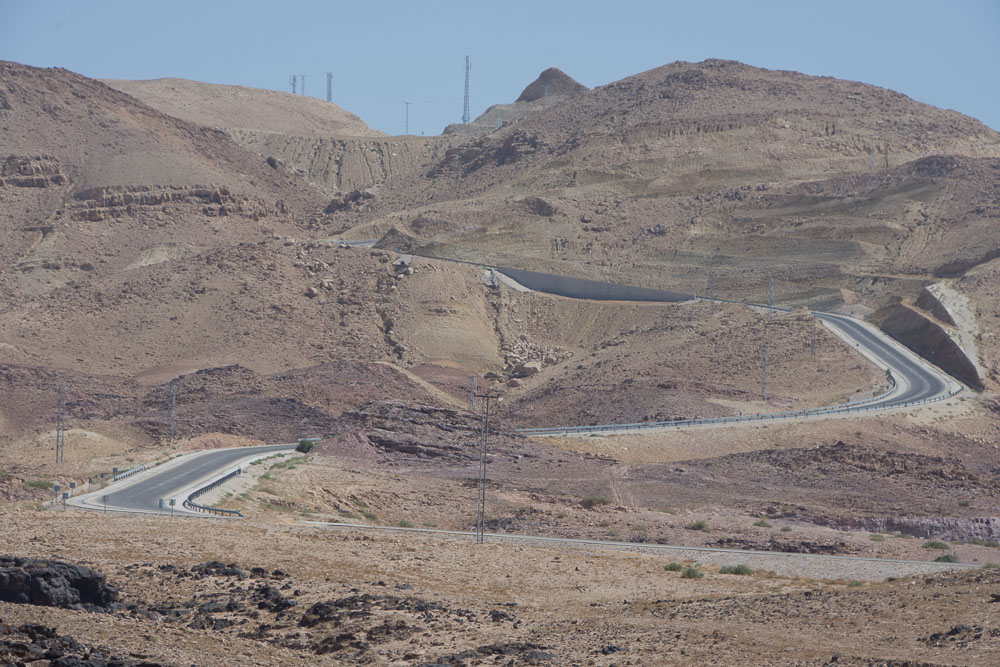
Jordan’s Dead Sea to Madaba road. It’s steep. Very steep!
We had some entertainment, however, when a passing motorist did a U-turn to join us for the climb. He drove next to us, urging us to stop and get in or to grab the side of the car for a pull. When we refused he flicked through the radio channels and, with windows down, our climbing was accompanied by an eclectic mix of music, which included Arabic pop songs, stirring classical music, iconic Eye of the Tiger and shouts of “you can do it” as he crawled along next to us.
Further up the mountain, we stopped for a breather and he offered us biscuits and, had I not been around, I’m certain he would have asked for Emily’s hand in marriage.
We continued our struggle up the mountain. We knocked back a few rehydration sachets. It was tough and we both struggled. Massively.
About two thirds of the way up another car pulled over and out came a gent who offered us water (which we gratefully accepted) and I tried an Arabic coffee that he offered me (tasted of cardamom). He warmly welcomed us to Jordan and asked we posed for a photo at his request.

Our new friend after he stopped to offer us water and Arabian coffee as we climb from the Dead sea to Madaba.
Nearly 6 hours later at an average speed of just 8km per hour, we completed our 1,600m climb that started from 395 meters below sea level and are now in Madaba. Emily has certainly earned her birthday drink tonight!
If you’ve enjoyed reading this blog post, please donate to World Bicycle Relief. Every penny goes to the great work the charity does in Africa – not to fund our expedition in any way.
A day I’d rather forget
/in London to Cape Town /by James DavisIt had to happen to one of us sooner or later. It just happened to be me that was first. What started as a good day, later descended into one I’d rather forget.
The day started well; we woke to beautiful misty views across the Danube and, after a quick bowl of cereal, we were on the road by 08:30.
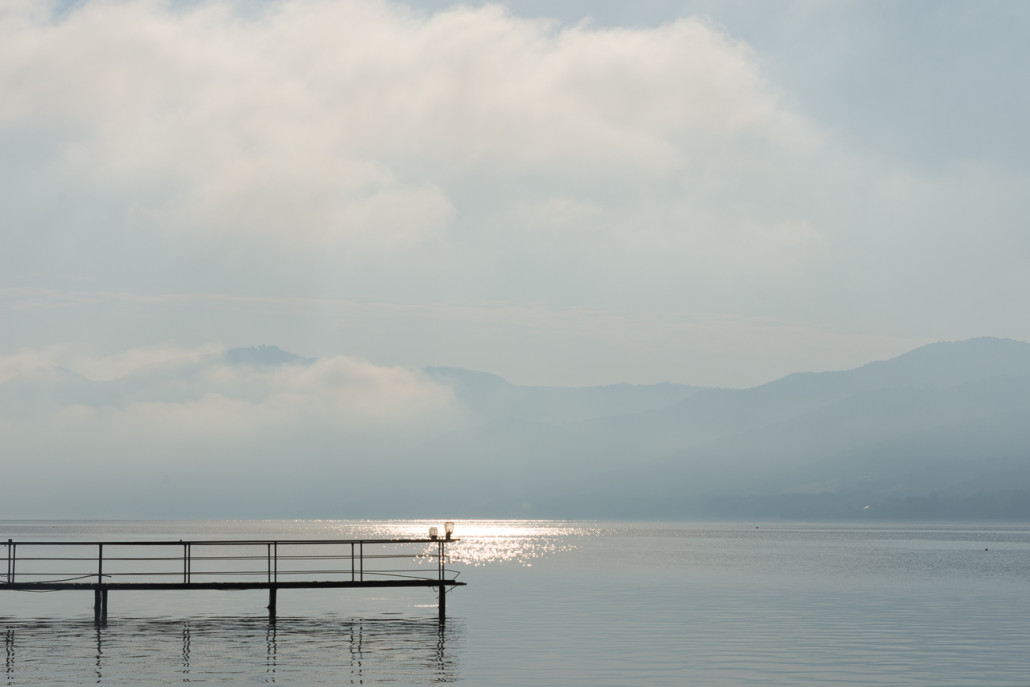
Misty morning on the Danube near Eşelniţa, Romania
There was sharp climb out of the village then, a few KMs into the ride, we joined the E70: a main trunk road adjacent to the Danube. After cycling on the Euro Velo 6 path and quiet country roads, it was a shock to the system to have countless lorries thunder past us. To be fair, there was a reasonable hard shoulder and the majority of the trucks gave us gave us plenty of room; but it was a bit hairy when we had to cycle through a tunnel with a juggernaut bearing down on us from behind.
The traffic eased off but the terrain didn’t. We started ascending the day’s main climb, which was about 6km long at 8%-10% gradient. It was now midday and we felt the full force of the sun on our faces. Sweat dripped from my forehead and pooled on the inner rims of my sunglasses until it poured, in one go, onto my shorts, mixing with the salt patterns that had already formed on my thighs from the previous days’ cycling.
At the summit, I spied a patch of shade by a layby and called for a quick time out out to get my breath back. As soon as I stopped the bike I didn’t feel well, but I couldn’t quite place why.
I managed to prop my bike up and leant against a concrete buttress at the side of the layby. Suddenly, a huge wave of dizziness hit me. The world in front of me rotated but I couldn’t focus on it. My legs went weak and, had I not had my back against the wall, I’d have fallen to the ground in the litter-strewn ditch.
I took a step forward and lay down on the filthy floor. A mangy mutt approached and licked its lips as If I were to be his first and only meal for the month.
At this point, Emily took over. She mixed a High5 energy drink and commanded me to drink it whilst force-feeding me sugary sweets.
Once I felt a little better, we decided to find somewhere more comfortable to rest so crossed the road towards a small stand where two kids were selling honey. Beside their stand was a large metal box, which was in the shade, so I motioned to them that I wanted to sit on it. They agreed that I could, but without looking me in the eye.
I sat on the box, tilted my head back and closed my eyes. I could hear buzzing. Was this a symptom of the dizziness? I opened my eyes and saw a cloud of bees buzzing by my head. It was only then that I released that the metal box I was sat on was one of the many mobile bee-hives we’ve seen in the fields throughout Serbia and Romania. I had sat on a beehive! The kids selling the honey looked on blankly, possibly wondering why anyone would do such a thing.
Emily got the stools out and, after another High5 and sugary sweets we moved on and tentatively took on the descent.
Emily decided it was time to eat, so a few KMs further on, we found a grassy spot under a big tree outside a police station. Sandwiches were consumed slowly; with every mouthful I had the overarching desire to fall asleep.
We discussed weather we should continue or find somewhere to rest up. I wanted to continue but, every time I got to my feet, I immediately had to lie down again. Emily was clearly concerned as to whether we should continue. I wanted to give it one last go because we still had over 80km to do so, after my 5th attempt, I made it onto the bike and back on to the road.
With about 75km on the clock, and the same distance again to go, we stopped at a petrol station to stock up on water. Sadly, with my first sip of water, my sandwiches reappeared in a somewhat more diluted form as a puddle by my feet.
However, I almost instantly felt better.
I got back on the bike and I plodded on, keeping on Emily’s back wheel for a further 25km along the trunk road. (No change there, some might say!).
We stopped at another fuel station and, as Emily went in to buy more water, I lay on my back on the paving at the side of the kiosk. This, apparently, caused a scene and, as Emily emerged from the shop, a couple of motorists asked her if I was OK. Right on cue, I scurried to the grass verge to be ill again. My body simply wasn’t taking in all the liquid I’d consumed.
Emily had a quick conference with a motorist who’d stopped and asked about accommodation nearby. The closest being 25km away. Our intended destination was still 40km away.
Again, I felt marginally better after being ill, so we got back on the bikes to see how further we could get. By this time, I’d lost all strength and if was an effort just to look at Emily’s back wheel let alone keep up with it.
It was a touh decision to make but, in the state I was, It would not have been possible to complete the 40km to our intended destination, Calafat.
We plugged the nearest accommodation into the sat nav and made our way towards that, 2km as the crow flies, but an agonizing 7km by road. All I wanted to do was lie down and go to sleep but Emily was really keen that we slept near to civilization and not in a field (just for peace of mind).
With 5km to go, the final hurdle was a short and steep hill; which I simply didn’t have the energy to climb. I looked at the map and thought I could see an off-road route that would bypass the hill so we pulled onto a track, where two farmers watched as I was ill again at the side of the road.
I was wrong about the shortcut so, we had to take on the hill. However, I simply didn’t have the energy. About a quarter of the way up I had stopped and Emily put her bike to one side, ascended on my bike and left it at the top, then ran down to walk with me and her bike up the hill. I simply couldn’t ride or push the bike up to the top, I cannot remember ever feeling this weak. I knew in my head it was only about 5km more to go, now downhill but it took every once of energy, and a lot of gentle encouragement to get me to the hotel on the banks of the Danube, some 30km short of our intended destination.
Emily was told that ‘they were full as they were holding s festival’ but after a bit of pleading and pointing in my direction (I was now a familiar position lying on my back at the side of the road) the hotelier miraculously found us a room.
I was ill once more en route to the bedroom, to the surprise of the hotel workers but once I was inside, it was a quick shower then a power nap.
We put the day’s episode down to dehydration. And it’s no surprise really. We’ve been cycling in temperatures in the late 30s and, foolishly, we haven’t been stopping for enough water since we have been in Romania – I think this is because there has not been a water pump in every village we pass through. Foolish in hindsight. I remembered that I hadn’t really drunk anything the night before whereas, normally, we’d drink at least a litre of water in the evenings.
Emily mixed up two rehydration sachets during the evening and, although I wasn’t able to eat anything, I spent the evening sipping salty drinks whilst listening to the sounds of the music and film festival outside.
The hotel itself was wonderful. It’s owned by a poet and they have various cultural events throughout the year. It was very tempting to stay another night there but, after a good breakfast, I managed to find a 30km shortcut meaning we didn’t have to add on yesterday’s missed mileage to reach tonight’s destination, Bechet where, I’m writing this sipping a water and feeling, thankfully better.
A lesson was learnt the hard way but we are both glad we have some decent first aid knowledge that allowed us to monitor our situation and stay safe.
If you’ve enjoyed reading this blog post, please donate to World Bicycle Relief. Every penny goes to the great work the charity does in Africa – not to fund our expedition in any way.

